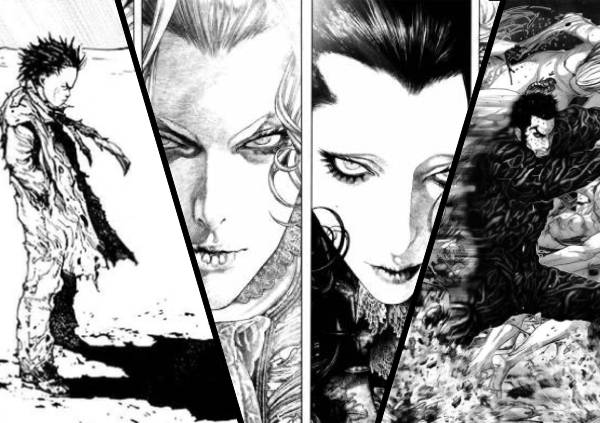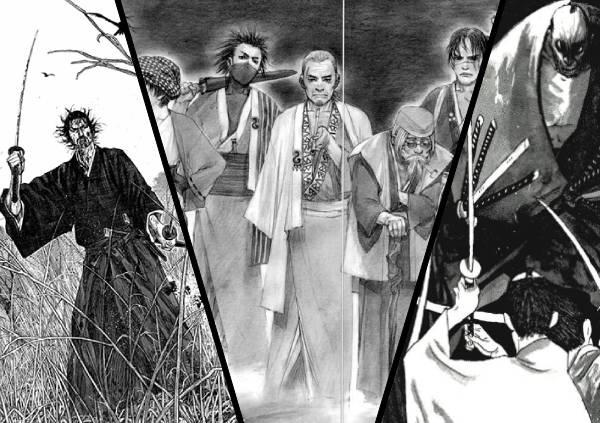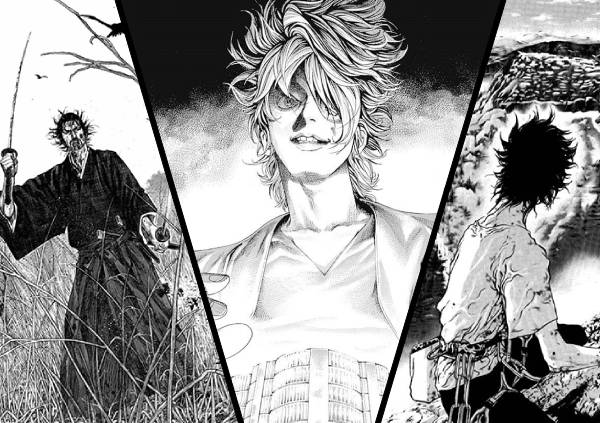I’ve always been a fan of darker, more twisted stories, and few genres embrace them as completely as dark fantasy manga. There’s something endlessly fascinating about grim worlds filled with grotesque creatures, cursed heroes, and dangerous magical powers. These stories often blend horror, tragedy, and epic fantasy into something uniquely haunting.
On this list, you’ll find everything from gothic thrillers and vampire tales to stories of militaristic brutality and humanity standing against unnatural monstrosities. Each of these series explores a different facet of darkness, whether through blood-soaked battlefields, cursed lands, or melancholic fairy-tale settings.
Dark fantasy has become one of the most beloved genres in manga, though not every title lives up to its potential. Many series rehash familiar tropes and story beats, offering little beyond predictable violence or edginess for its own sake. Yet, a few truly stand out, works that elevate the genre through atmosphere, worldbuilding, and emotional depth. This list is dedicated to these exceptional titles.
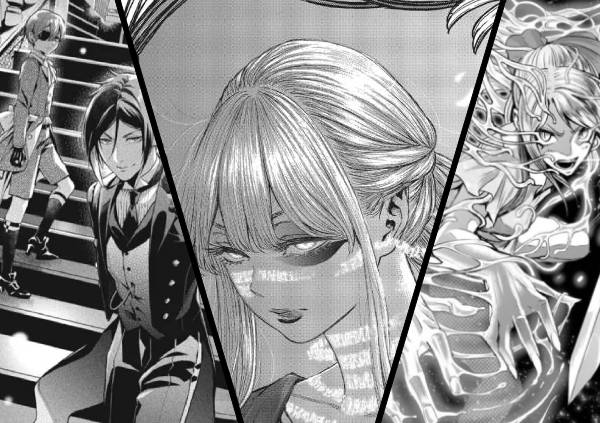
Some unfold in sprawling, tragic worlds like Berserk and Claymore, while others, such as Black Butler or March Story, embrace a rich gothic aesthetic. Then there are stories like Dorohedoro or The Girl From the Other Side, which conjure up entirely unique worlds of their own. All of them, however, have one thing in common: they are unforgettable reads for anyone drawn to dark, twisted, or emotionally charged tales.
If you’re looking for lighter or more traditional fantasy stories, check out my list of the best fantasy manga, filled with grand adventures or magical coming-of-age tales.
Mild spoiler warning: I’ll avoid major reveals, but some plot details may be mentioned to give context to each series.
With that said, here’s my list of the 21 best dark fantasy manga to read right now (last updated: October 2025).
21. Rosen Garten Saga
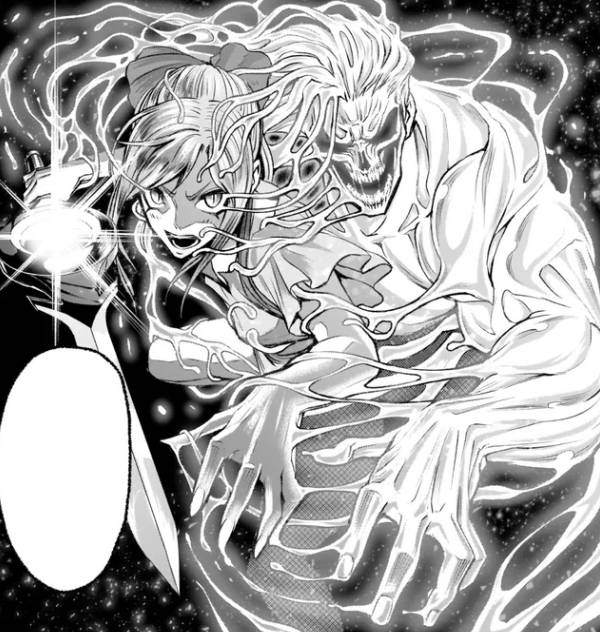
Rosen Garten Saga is an outlier on this list, and likely the most explicit title ever classified as a dark fantasy manga. It’s a hentai-adjacent sex comedy overflowing with depravity, featuring nearly every taboo imaginable: rape, masochism, cuckolding, gender-bending, traps, lolis, and more. It’s unapologetically obscene, proudly offensive, and yet somehow brilliant.
At its core, Rosen Garten Saga is a darkly comedic retelling of the Nibelungenlied as a tournament battle manga. The story follows Rin, a young woman who decides to join after her village was attacked, wielding a magical sword containing the soul of the hero Siegfried. Around her gathers a cast of other legendary figures from myth and folklore, including Brunhild, Beowulf, King Arthur, Dietrich von Bern, and even Alibaba, but none of them are what you remember. Here, they’ve all been reimagined as hysterically degenerate caricatures: Siegfried is a virgin-obsessed deviant, Dietrich a masochist, Beowulf a proud exhibitionist, and Arthur and his knights? They are now an idol band entirely composed of traps.
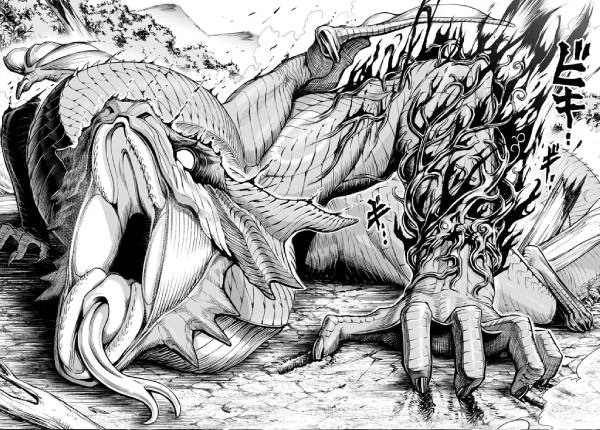
If this sounds insane, it’s because, well, it is. Rosen Garten Saga doesn’t just break taboos, it destroys them. Every chapter is an exercise in absurd escalation, filled with graphic nudity, sexualized fighting styles, and jokes so unhinged they become surreal. It’s a manga where people literally fight with their fetishes and private parts, and yet the sheer commitment makes it impossible to look away. Rather than erotic, the result feels grotesque, chaotic, and genuinely hilarious.
What makes Rosen Garten Saga genuinely impressive, though, is that it shouldn’t look this good. The artwork is fantastic, clean, detailed, and bursting with energy. Every fight is beautifully choreographed, with dynamic paneling that rivals mainstream battle manga. These fights are absurd and over-the-top, yet drawn with such precision that you can’t help but be invested. It’s the type of series that makes you laugh on one page and gasp at the art on the next.

Despite its constant barrage of degeneracy, Rosen Garten Saga never feels lazy. Beneath the chaos, there’s real effort and creative spark, from its playful reinterpretations of mythological figures to its surprisingly coherent story structure, and the occasional beat of genuinely good character development. It’s a self-aware parody, but never a soulless one. You can tell the author cares about the craft, even while gleefully tearing down every boundary of good taste.
Of course, this isn’t a manga for everyone. Many readers will bounce off within the first chapter, and that’s completely understandable. It’s offensive, grotesque, and profoundly unfiltered. But if you can stomach the excess and appreciate the genius behind the depravity, Rosen Garten Saga is one of the most unhinged and entertaining dark fantasy manga ever written. To me, it’s the greatest manga I can never openly recommend to anyone, and that’s exactly why it deserves a spot on this list.
Genres: Action, Adventure, Comedy, Dark Fantasy, Erotica
Status: Ongoing (Seinen)
20. Kurogane no Valhallian
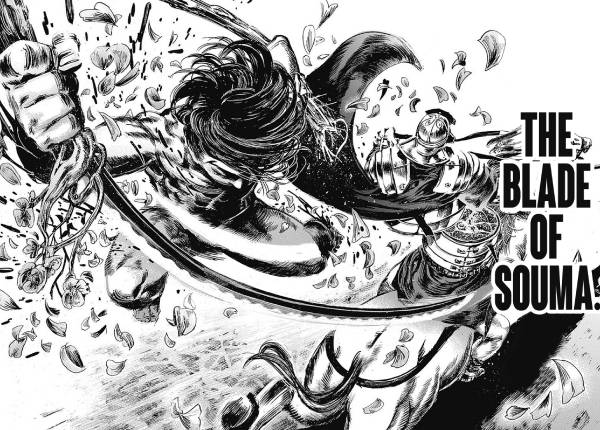
Kurogane no Valhallian is one of those rare titles that takes a familiar premise and pushes it to its limits. It’s essentially an isekai battle manga, except our protagonist isn’t sent to another world, but to Valhalla, the resting place of fallen warriors. This premise alone sets it apart and places it firmly in the realm of dark fantasy.
The story follows Tetsujirou Souma, a samurai who survived the Mongol invasion of Japan during the Kamakura period. After his untimely death, he awakens in Valhalla, where legendary heroes and warlords from across history battle for a chance at reincarnation. Guided by a mysterious Valkyrie named Hrist, Tetsujirou quickly learns that the only way to survive is to fight. What follows is a mythological war filled with brutal battles, ancient heroes, and spectacular duels.
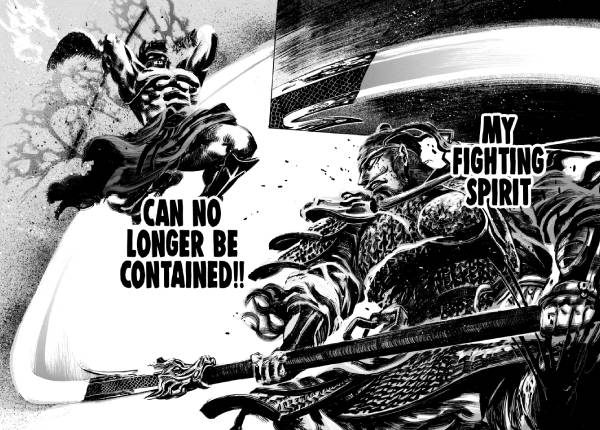
The main appeal of Kurogane no Valhallian lies in its premise. Seeing Tetsujirou team up with warriors like Guan Yu, Kublai Khan, and Spartacus to face enemies such as Crassus or Napoleon is pure thrill. It’s not a deep or philosophical story, but it perfectly captures the excitement of seeing historical icons clash in beautifully illustrated, over-the-top combat sequences. Each new battle introduces another famous warrior from a different era, keeping things fresh and unpredictable.
Toshimitsu Matsubara’s art is one of the manga’s biggest strengths. The linework is detailed and dynamic, capturing both the ferocity of combat and the grandeur of its setting. Massive double-page spreads showcase chaotic army engagements, and while the violence is intense and visceral, it never becomes unreadable.
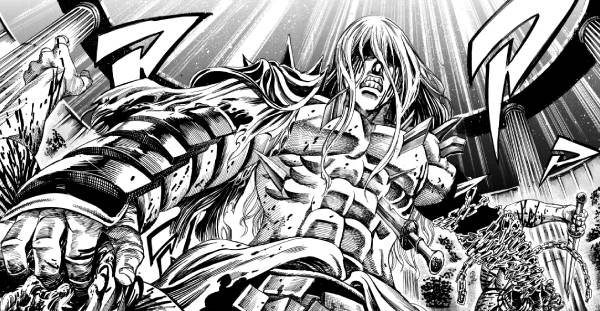
That said, the manga’s characters are archetypal, and the story often prioritizes spectacle over development. There are a few stretches where the pacing slows under its own weight, and the ending arrives a bit too early. Readers seeking nonstop action will get exactly that, a constant stream of heroic clashes.
At its best, Kurogane no Valhallian feels like Record of Ragnarok mixed with classical samurai action, filtered through a darker, more mythological lens. As a dark fantasy manga, it may not be profound, but it’s undeniably entertaining. Seeing legendary figures fight through the afterlife is an absolute joy, and what makes Kurogane no Valhallian one of the most exciting hidden gems in the genre.
Genres: Action, Isekai, Dark Fantasy, Historical
Status: Completed (Seinen)
19. Ragna Crimson
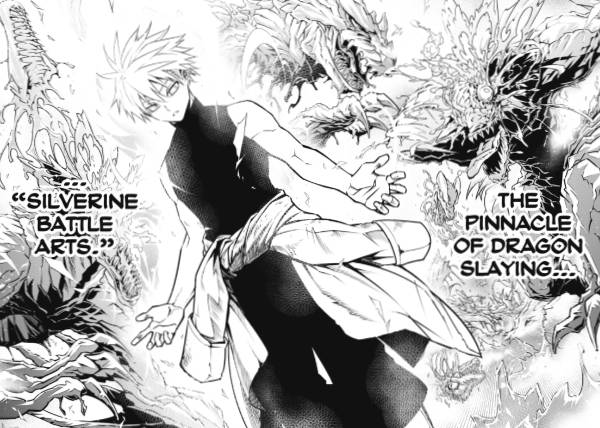
Ragna Crimson is one of the newer, flashier entries on this list. It may lack the depth or maturity of classic dark fantasy manga, but it more than makes up for it with style and pure entertainment value. It’s the kind of manga that takes a familiar trope and keeps you turning the pages to see how wild it can get.
Set in a world ruled by dragons, the story follows Ragna, a young dragon hunter who dreams of protecting his companion, Leonica. It begins with a fairly typical shonen setup, an illusion that’s shattered almost immediately. Within the first chapter, Ragna’s fate takes an unexpected turn that completely changes the story’s direction.

The story truly takes off once Ragna joins forces with the mysterious and morally ambiguous Crimson. Together, they set out to destroy the dragon monarchs who dominate the world, though Crimson’s true motivations remain unclear. The dynamic between the two of them is the backbone of the series. Ragna is the straightforward warrior driven by revenge, while Crimson is a manipulative schemer whose cunning and cruelty make him feel like both enemy and ally at once. Their chemistry is chaotic, shifting between serious and absurd, but it always keeps the story unpredictable.
As a dark fantasy manga, Ragna Crimson mixes familiar elements such as swords, sorcery, and monsters with moments of genuine horror and despair. The worldbuilding is ambitious, filled with various kingdoms, monstrous dragon lords, and strange technology. The inclusion of guns and machinery alongside medieval magic can feel jarring, but later reveals hint at a logical explanation.
The artwork is another major draw. The action scenes are beautifully drawn and brutal, with plenty of energy and flair. The artist clearly knows how to stage a fight, even if some panels can be difficult to follow.

However, the manga isn’t without flaws. The early chapters are weak, rushing through key moments and relying too heavily on revenge tropes. It’s only during the capital arc that Ragna Crimson beings to shine, as the series finds its rhythm with large-scale battles and more complex antagonists. The supporting cast is a mixed bag of archetypal side characters and the occasional comic relief. Ironically, the dragon monarchs turn out to be the most interesting characters, with many of them displaying genuine personality and emotional depth that surpasses the heroes.
Despite its flaws, Ragna Crimson is an addictive, thrilling read and one of the most promising modern dark fantasy manga currently running. It’s far from perfect, but for those looking for an exciting mix of brutality, spectacle, and mystery, I highly recommend it.
Genres: Action, Adventure, Dark Fantasy
Status: Ongoing (Shonen)
18. Centuria
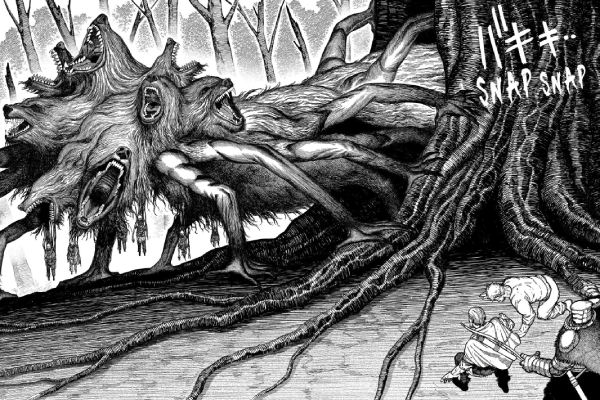
Among the new wave of modern dark fantasy manga, Centuria by Tohru Kuramori stands out as one of the most compelling. It’s a grim mythic tale that begins with a scene of pure brutality and never lets go of the same intensity. The story opens aboard a slave ship caught in a violent storm, where ninety-nine captives are slaughtered before a mysterious sea god intervenes. The sole survivor is a teenage boy named Julian, who receives unfathomable power from the entity. From that moment on, his fate becomes inseparable from the supernatural forces that rule this world.
The opening chapters instantly set Centuria’s darker tone. There’s something mythic in how Kuramori depicts the sea god, the monstrous creatures, and the world’s cold indifference to human suffering. It carries an eerie, Lovecraftian energy that’s rarely found in shonen manga. Julian’s journey from traumatized survivor to reluctant protector feels both tragic and purposeful.
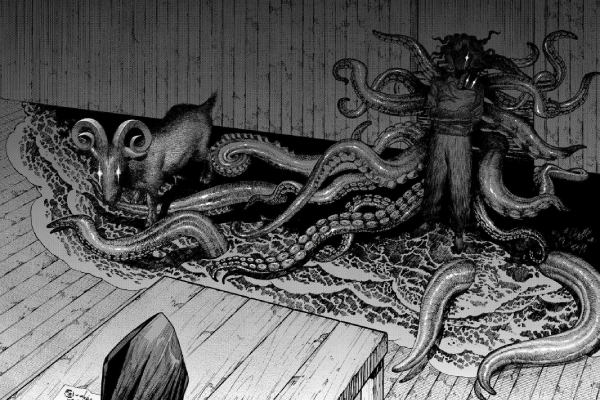
Visually, Centuria is stunning. Kuramori’s art balances raw emotion with intricate, highly detailed design work. The monsters are grotesque yet fascinating, drawn with such natural detail that each one feels alive. Landscapes and large-scale battles are beautifully rendered, giving the manga a cinematic sense of scope. While it’s easy to compare it to works like Berserk, Centuria carves out its own unique identity, blending mysticism with surreal imagery.
Yet despite its dark atmosphere, Centuria is still firmly rooted in the shonen genre. The story’s tone and visuals often suggest moral ambiguity, yet the characters remain straightforward. Many are clearly drawn as heroes or villains, righteous or monstrous, leaving little room for nuance and moral grayness. The most recent arc also leans heavily into action, allowing long battle sequences to dominate the narrative and thin out the pacing.

That being said, Centuria remains a captivating read, particularly as larger, more intriguing mysteries surrounding Julian and the world at large begin to unfold. This keeps the series engaging, even when fights overstay their welcome. There’s a constant sense of foreboding, as if a much larger conspiracy is at play.
Despite its shonen simplicity and occasional pacing issues, Centuria stands among the most promising dark fantasy manga in recent years. It captures the feeling of myth and nightmare, offering a tale that’s both violent and strangely intriguing. If you’re looking for an ongoing dark fantasy manga that blends mythological horror, cinematic artwork, and just enough mystery to keep you hooked, Centuria is worth reading.
Genres: Horror, Dark Fantasy, Action, Supernatural
Status: Ongoing (Shonen)
17. March Story
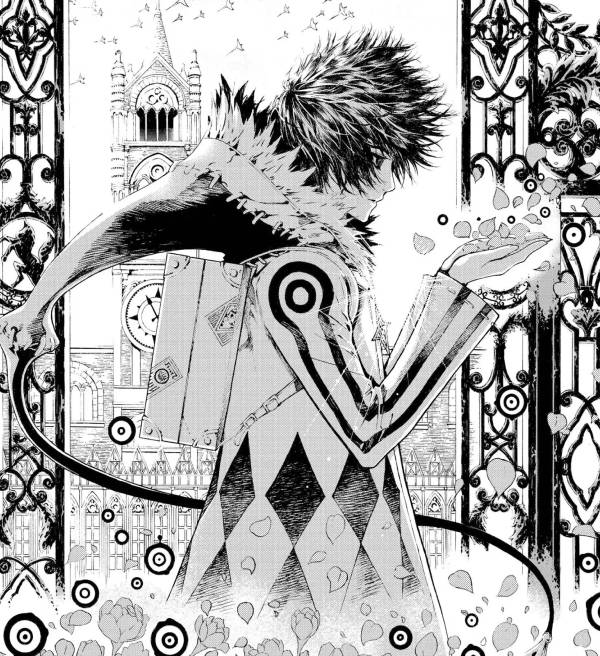
March Story is one of the most visually stunning and stylistically unique entries on this list. Created by Korean artists Hyung Min and Kyung-il Yang but serialized in Japan, it blurs the boundaries between manga and manhwa. Despite its unusual origins, it fully deserves recognition as one of the most striking dark fantasy manga of the modern era.
Set in 18th-century Europe, March Story unfolds across misty villages and ornate cities. Within this beautiful setting lurk the Ill, demons that hide in masterpieces of art, jewelry, and antiques, born from the anguish and regret of their creators. Those who are drawn to their beauty risk being possessed and driven to madness. To prevent such tragedies, the Ciste Vihad roam the land, hunting the Ill and purging them before they can claim more victims. One of these hunters is March, whose own past is intertwined with these very demons.
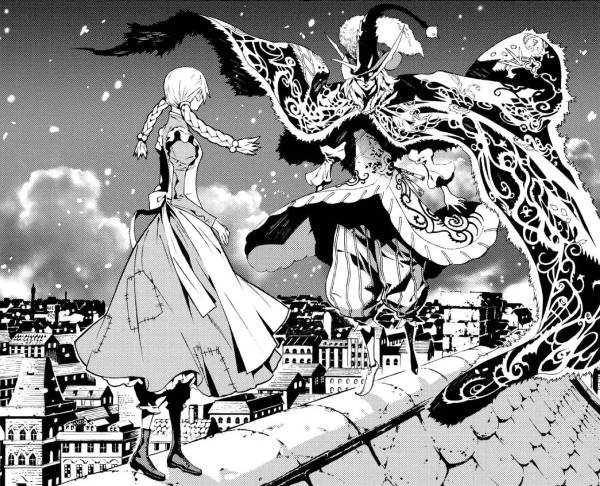
At its core, March Story reads like a gothic fairy tale filtered through the lens of horror. Its episodic structure allows for haunting, self-contained tales, often revolving around a cursed object or possessed soul, yet a quiet melancholy runs beneath the blood and violence. Flashbacks gradually reveal March’s tragic story and the curse that defines it. The narrative patiently weaves together these threads, leading to a powerful, emotional conclusion in its final chapters.
The art is nothing short of breathtaking. Kyung-il Yang, known for Shin Angyo Onshi, brings an extraordinary level of craftsmanship to every panel. Baroque architecture, elaborate costumes, and intricately designed monsters give the series a luxurious, almost painterly aesthetic. It’s a work that drips with atmosphere, balancing elegance and grotesqueness. When violence erupts, it’s rendered with cinematic precision, and even the most horrific scenes retain a strange beauty. Few works blend such detailed art with such a haunting tone.

However, March Story is far from perfect. Its tone shifts can be jarring, moving from grim gothic horror to sudden bursts of comedy or melodrama that sometimes undercut the story’s seriousness. Some supporting characters, like Belma, serve mostly as comic relief rather than meaningful participants for large stretches of the story. While effective early on, the episodic structure sometimes leaves the story fragmented, and the manga’s short length makes the ending feel abrupt.
Even so, March Story remains a hidden gem. Beneath its tonal inconsistencies lies a genuinely beautiful and tragic narrative, carried by one of the best art styles in dark fantasy. It combines gothic aesthetics, mythic themes, and emotional storytelling to create something memorable and distinct. While it may not have the depth or consistency of Berserk or The Witch and the Beast, it easily ranks among the most visually stunning and atmospheric dark fantasy manga of the 21st century.
Genres: Action, Supernatural, Gothic, Dark Fantasy
Status: Completed (Seinen)
16. The Girl From the Other Side: Siúil, a Rún
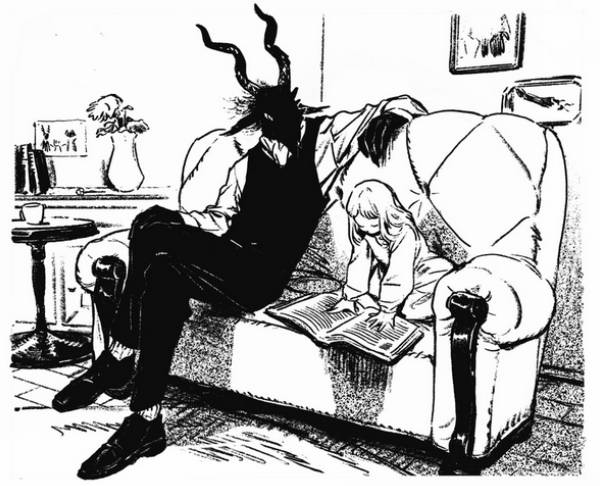
The Girl From the Other Side: Siúil, a Rún is one of the most haunting and melancholic dark fantasy manga ever written. Set in a world divided between the Inside and the Outside, it tells the quiet, sorrowful tale of two unlikely companions: a cursed, beastly Outsider known only as Sensei, and a young human girl named Shiva. The two live together in exile, unable to touch each other because of a cruel law of nature: if a human touches an Outsider, they too become cursed. What unfolds is a slow, dreamlike story about love, loneliness, and the boundaries that separate people from one another.
The manga’s world feels like something straight out of a fairy tale. The Inside and the Outside may be part of the same world, but they are divided by superstition and cruelty. Anyone found entering the Outside is branded as cursed and forbidden from ever returning. It is here that the relationship between Shiva and Sensei becomes profoundly human. Their bond, filled with warmth and melancholy, gives the series its emotional weight.
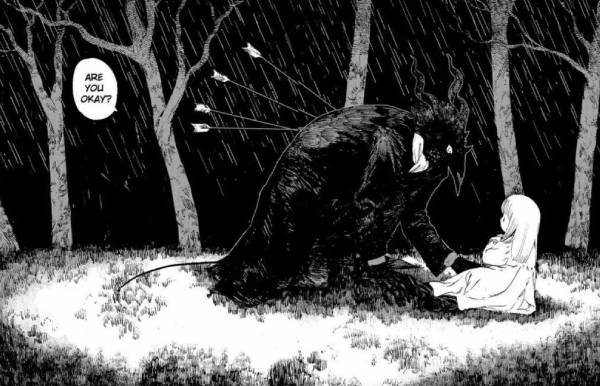
What makes The Girl From the Other Side truly stand out is its art. The illustrations are sparse and delicate, resembling old European picture books, with thick ink lines and gentle shading that evoke classic woodcut prints. The stillness of its pages, the silence between words, and the graceful movement of its characters create an experience closer to visual poetry than to a typical fantasy narrative.
However, this also means the manga is not for everyone. The pacing is glacial, and at times entire chapters pass with almost no advancement in the plot. It’s a story more concerned with mood and subtle emotion than with major twists or revelations. For some readers, this can feel profound; for others, it can feel frustratingly slow and even pretentious. The later chapters shift from quiet, fairy-tale-like storytelling to dense worldbuilding and lore expansion, introducing political plots and divine mysteries that clash with the intimate tone of the earlier volumes. The ending, though touching and thematically fitting, is also ambiguous, leaving readers divided.
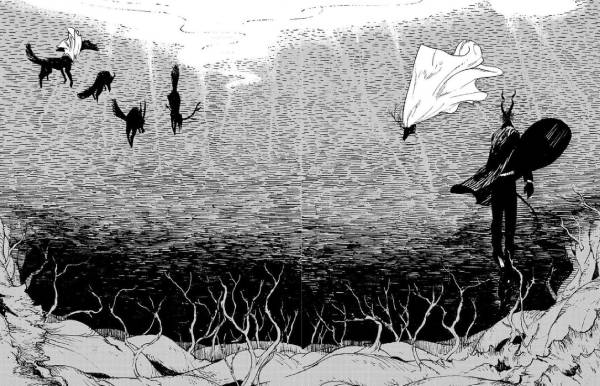
Despite these flaws, The Girl From the Other Side remains a work of quiet brilliance. It captures the essence of dark fantasy not through blood and violence, but through mood, isolation, and grief. Readers who appreciate slower, more atmospheric works will find it mesmerizing, while those looking for action and traditional pacing may struggle.
In the end, The Girl From the Other Side: Siúil, a Rún stands as one of the most unique and emotionally resonant dark fantasy manga of the past decade. Its picture-book art style, haunting tone, and tragic tenderness give it a timeless quality, like a forgotten fairy tale.
Genres: Supernatural, Dark Fantasy, Slice-of-Life, Drama
Status: Completed (Seinen)
15. What Do You Wish For With Those Murky Eyes: Record of Highserk War
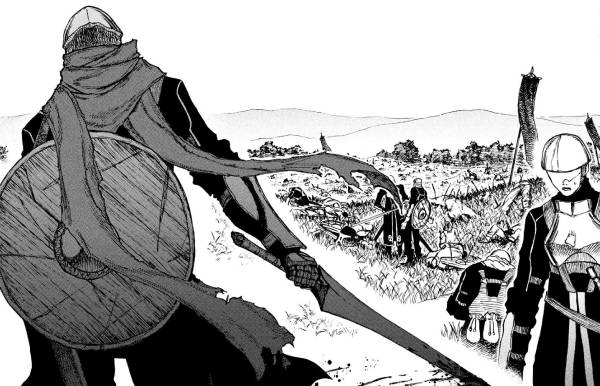
What Do You Wish For With Those Murky Eyes: Record of Highserk War is one of the most brutal and grounded dark fantasy manga in recent years. Technically an isekai, it abandons nearly every familiar trope of the genre. There are no cheat skills or item inventories, no overpowered heroes or colorful cast of allies. Instead, this story drops us into a grim medieval world consumed by endless warfare.
The protagonist Raizou Takakura dies of a heart attack in modern Japan and is reborn as Walm, the third son of a poor farmer in a small empire surrounded by enemies. He grows up to become a soldier in the Highserk Empire’s army, fighting a war with no clear heroes or villains. From the first battle, it’s clear this is no power fantasy. Walm is competent, even gifted, but far from unstoppable. He bleeds, is afraid, and suffers through exhaustion and guilt as he slaughters men just as desperate as himself.

Rather than following the typical isekai structure, Highserk War reads more like a military drama set in a dark fantasy world. Magic exists, but it’s treated as a terrifying weapon rather than a flashy trick. Walm’s gradual mastery of it enhances his survival, but he never ascends into a superhuman figure.
The tone is bleak yet restrained. The manga explores the futility and hypocrisy of war, painting every nation in shades of gray. The Highserk Empire is the defender, but it’s no better than its enemies. There’s no moral high ground here. Instead, there’s only war, and it’s mechanical, necessary, and soul-crushing. Walm himself becomes the embodiment of the title’s murky eyes, a man who’s seen too much.
Art plays a huge role in creating this atmosphere. The battlefields are dense with details; armor, flames, and falling bodies are rendered with such clarity that the chaos feels tangible. The designs of the various nations, soldiers, and weapons are impressive, adding depth to a world that feels alive and dangerous.
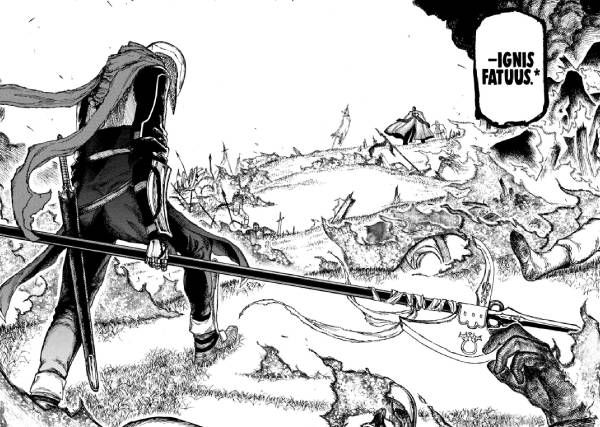
There are flaws, of course. The pacing can be uneven, and with only twenty-five chapters released, the story feels incomplete. Some readers feel that Walm’s introspection doesn’t run deep enough; others feel the world’s politics aren’t explored thoroughly enough. Yet for all its roughness, Highserk War succeeds where most isekai fail: it feels real.
If you’re tired of cheerful fantasy worlds with invincible heroes, What Do You Wish For With Those Murky Eyes: Record of Highserk War offers something different. It’s a story of soldiers drowning in war, where victory and defeat are equally hollow. This is dark fantasy manga at its most grounded, merciless, and human.
Genres: Action, Drama, Dark Fantasy, Military, Isekai
Status: Ongoing (Seinen)
14. Übel Blatt

Few manga embody the raw, unfiltered energy of dark fantasy quite like Übel Blatt. This long-running series, written and illustrated by Etorouji Shiono, begins as a tale of vengeance soaked in blood and betrayal, then mutates into a sweeping war epic. It’s grim, violent, sexual, and unapologetically over-the-top, the kind of manga that feels ripped straight from a heavy metal album.
The story opens with the legend of the Seven Heroes, who once saved the empire from invasion. When the so-called Four Lances of Betrayal resurface, a mysterious silver-haired swordsman named Köinzell appears. Out for revenge against the Lances, his black sword and signature scar soon become symbols of fear and hope.
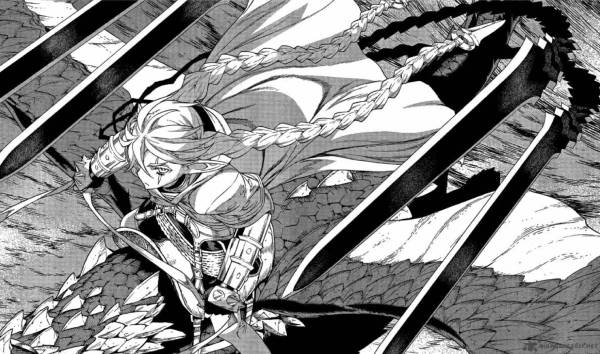
The early chapters of Übel Blatt are peak grimdark fantasy. Heads roll, blood flows, and morality barely exists. It’s brutal, at times overly sexual, and full of atrocities, but also deeply atmospheric. Shiono’s artwork shines here, with moody medieval towns, towering fortresses, and grotesque battles that capture both grandeur and filth. Köinzell’s vengeance is ferocious but tinged with tragedy. He’s not a mindless killer, but a haunted remnant of a forgotten era. Many fans call these first arcs some of the best storytelling in dark fantasy.
Unfortunately, Übel Blatt’s long publication history, spanning over fifteen years and several magazines, left its tone uneven. After its first major hiatus, the story shifts away from its original revenge narrative and toward broader political intrigue and warfare. The second half introduces different kingdoms, scheming nobles, and massive armies. While these later arcs expand the worldbuilding and add scale, they also soften the story’s original edge. The series gradually becomes more shonen-style adventure full of moral speeches and subplots that clash with its grim origins.
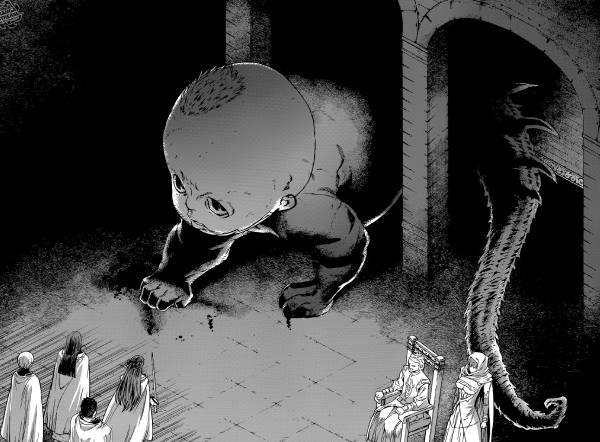
The other major shift is in tone and presentation. Nudity and sexual content were always present, and while explicit, they initially fit the story’s darker themes. Later volumes, however, edge into outright hentai territory. While this might be a product of editorial pressure rather than authorial intent, it dilutes the raw, brooding energy that defined the manga. Still, even in its messier stretches, Übel Blatt never stops being entertaining. There’s an undeniable thrill in its grand battles, gothic architecture, and the sheer audacity of its world and characters.
In the end, Übel Blatt is a series of extremes. Its best chapters make it an exceptional dark fantasy manga, blood-soaked, tragic, and unapologetically mature. Its weakest moments falter under shonen tropes and overindulgence. For fans of grim worlds, cursed heroes, and metal-infused violence, it remains an unforgettable read.
Genres: Action, Adventure, Dark Fantasy, Revenge, Erotica
Status: Completed (Seinen)
13. Bastard!!
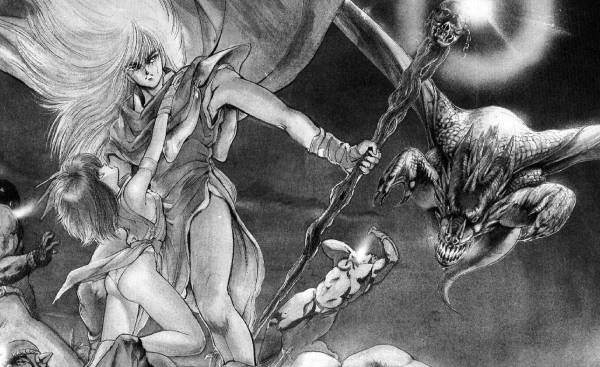
Before Berserk became the face of dark fantasy manga, there was Bastard!!, an unholy fusion of swords, sorcery, and heavy metal chaos. Written and illustrated by Kazushi Hagiwara, it’s one of the most influential works of the genre, a monument to 1980s excess.
Set in a fantasy world where humanity is under siege by monsters, orcs, and demons, the last hope of salvation lies in something even more dangerous: Dark Schneider, the world’s most arrogant, and ridiculously overpowered wizard. Once sealed inside a young boy, he’s resurrected to battle his former allies, four dark generals plotting to revive the god of destruction, Antharsax.
From the start, Bastard!! is a glorious train wreck of metal-inspired fantasy. The story begins with dungeon-crawling battles and demonic invasions, all backed by an aesthetic straight out of an ‘80s album cover: long hair, leather, fireballs, and cleavage. Dark Schneider himself is the embodiment of unrestrained excess. He’s proud, ruthless, absurdly funny, and utterly self-absorbed. He kills as if it’s nothing, seduces enemies, mocks allies, and can never shut up. Yet he’s so charismatic you can’t help but love him.
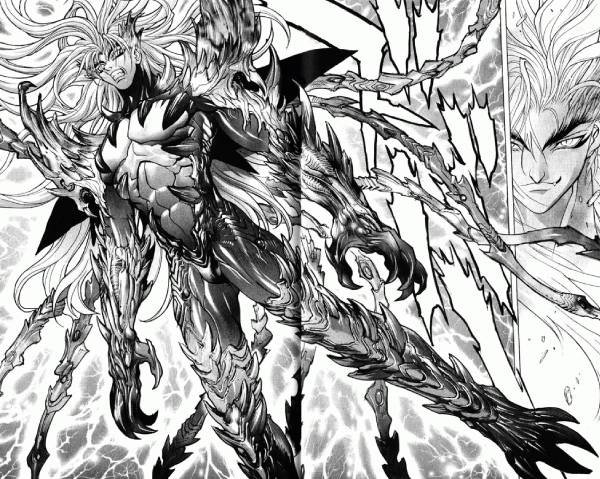
What really defines Bastard!! is its evolution from edgy dungeon fantasy to apocalyptic madness. The early volumes are violent, funny, and easy to follow, but halfway through, the series takes a wild turn into divine warfare, introducing angels, gods, and cosmic revelations. The tone shifts from raunchy fantasy adventure to an all-out theological fever dream. The world expands to mythic proportions, the art becomes breathtakingly detailed, but the plot borders on incomprehensible. It’s messy, disjointed, and surreal, but also fascinating in its audacity.
Visually, Hagiwara’s art evolved into something legendary. What began as a solid 1980s shonen aesthetic eventually became some of the most intricate, highly detailed artwork in manga, full of gothic architecture, celestial beings, and armor design that would influence a plethora of modern fantasy works. His love of Western metal culture is unmistakable. Characters, spells, and even entire kingdoms are named after bands and albums, giving the world a raw, rebellious flavor.

Of course, Bastard!! is notorious for its adult content. Violence, nudity, and sexualized character designs are everywhere, sometimes absurdly so. This isn’t a manga that hides what it is. It’s indulgent, self-aware, and proud of its own vulgarity.
In short, Bastard!! is one of the dark fantasy manga that defined the genre’s aesthetic and attitude before the era of grim realism. For fans of Übel Blatt and Berserk, or anyone who just wants to watch a narcissistic demigod scream metal-sounding spells, it’s pure, glorious madness.
Genres: Action, Adventure, Dark Fantasy, Heavy Metal, Erotica
Status: On Hiatus / Unfinished (Seinen)
12. The Case Study of Vanitas

Jun Mochizuki is most famous for her manga Pandora Hearts, and many fans would agree that it’s her best work. Personally, I prefer The Case Study of Vanitas. Both works stand out for their ornate worlds full of beauty and tragedy. In The Case Study of Vanitas, however, she refined her vision into something both elegant and haunting. It’s a vampire-themed dark fantasy manga that fuses steampunk Paris with psychological complexity and gothic horror. It’s not as relentlessly bleak as Berserk or Übel Blatt, but its emotional darkness and quiet melancholy easily earn it a place among the most atmospheric works of the genre.
The story takes place in an alternate 19th-century Paris, where vampires coexist with humans. They aren’t monsters by nature. Instead, they live ordinary lives, working, socializing, and maintaining their own society. That is, until their true names become corrupted, and they are driven to madness. Vanitas, a human doctor, claims he can heal cursed vampires with a mysterious grimoire known as the Book of Vanitas. Alongside Noé Archiviste, a vampire scholar, Vanitas travels through Paris attempting to cure the afflicted.

It’s a fascinating premise: a world where vampirism is treated as a disease rather than a curse, and salvation comes not through faith or violence but through understanding and science. Mochizuki turns familiar gothic horror tropes on their head, offering a surprisingly modern take on the genre while still embracing the elegance of Victorian melodrama.
Visually, The Case Study of Vanitas is stunning. Mochizuki’s art has evolved far beyond Pandora Hearts. The manga is full of ornate, intricate costumes, expressive faces, and fluid motion. The steampunk elements blend seamlessly with the gothic architecture, creating an elegant and otherworldly setting filled with airships, ballrooms, cathedrals, and moonlit streets.
The characters themselves are the heart of the manga. Vanitas is both charismatic and infuriating, a joker whose motives are never fully clear. His chemistry with Noé carries the story, alternating between banter, rivalry, and quiet moments of trust. Jeanne, a warrior bound by duty and trauma, adds another layer of emotional tension. Mochizuki’s characters are defined by contradiction: strength and vulnerability, humor and despair, cruelty and compassion.

That said, The Case Study of Vanitas can be uneven in tone. Mochizuki often mixes intense drama with broad comedy, and that humor doesn’t always land. Early chapters are especially guilty of jarring tonal shifts, where slapstick gags interrupt otherwise haunting scenes. Fortunately, as the series matures, it gives more weight to the darker, more introspective aspects of its world.
Despite these missteps, The Case Study of Vanitas stands out for its intricate worldbuilding and layered storytelling. It’s one of the most beautiful dark fantasy manga ever made, a gothic mystery and romance, exploring the line between monster and human.
Genres: Historical, Dark Fantasy, Vampire, Supernatural, Gothic
Status: Ongoing (Shonen)
11. Goblin Slayer

Few manga embody the spirit of a Dungeons & Dragons campaign quite like Goblin Slayer. Adapted from Kumo Kagyu’s light novel series, it feels like someone took a dark and savage tabletop adventure and made it into a manga. This is a world in which adventurers die screaming in caves, and even the smallest monsters are capable of the most unspeakable acts.
At its core, Goblin Slayer is brutally simple: a lone warrior known only by his title devotes his life to exterminating goblins. While most adventurers chase glory or riches, he takes only goblin-related missions, hunting them with terrifying efficiency. Along the way, he rescues a young priestess from a disastrous first quest and reluctantly builds a small party around himself.
The premise sounds laughably straightforward, but Goblin Slayer thrives on this focus. Every fight and every dungeon crawl feel grounded. Tactics, preparations, and realism take center stage. Traps, torches, poisons, chockpoints: they not only matter but are vital. When Goblin Slayer fights, it’s not flashy or heroic. It’s dirty, methodical, and brutal.
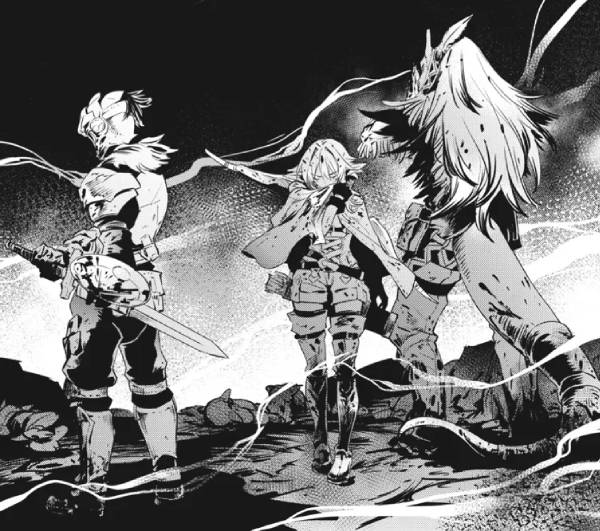
Artistically, the series is strong. While its everyday settings and cityscapes can feel uninspired, the manga truly shines during its battles. They are dense, kinetic, and brutal, full of smoke, blood, and motion. The goblins themselves are filthy, malicious creatures, terrifying not because of their size but their sheer number. The paneling can occasionally get chaotic, but the visual direction makes its dungeons feel claustrophobic and deadly.
That said, Goblin Slayer is not for everyone. Its first chapter famously shocked readers with a disturbing depiction of sexual violence, setting the tone for its grim world. In this setting, goblins reproduce through rape, and while later chapters rarely show it in detail, the aftermath and trauma remain a recurring element. The manga never eroticizes or glorifies it, but readers should still know this edge is central to the story.
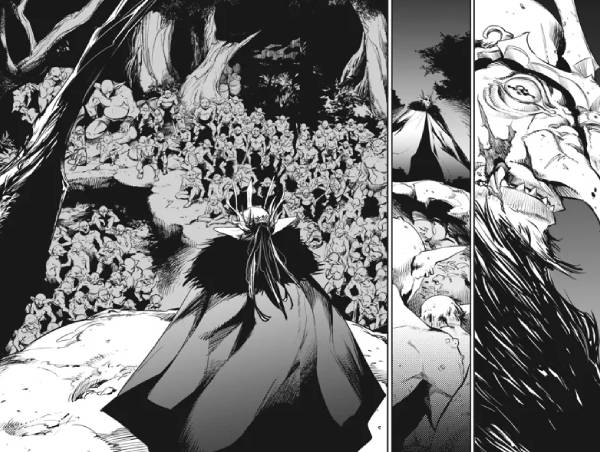
The manga’s greatest strength, the hyper-focused, episodic nature of dungeon crawls, is also its biggest weakness. The story doesn’t evolve much, and major plot arcs are rare. It’s largely a goblin-hunt-of-the-week structure, punctuated by the rare breath of worldbuilding or Goblin Slayer’s tragic past. Character development, too, is minimal, and while its characters can be endearing, they are archetypal by design, each representing a DnD class made flesh.
For some readers, this simplicity might be disappointing. For others, it’s exactly the point. Goblin Slayer is the dark fantasy manga equivalent of a dungeon crawl: repetitive, yes, but intentionally so.
Genres: Dark Fantasy, Action, Adventure
Status: Ongoing (Seinen)
10. Tower Dungeon
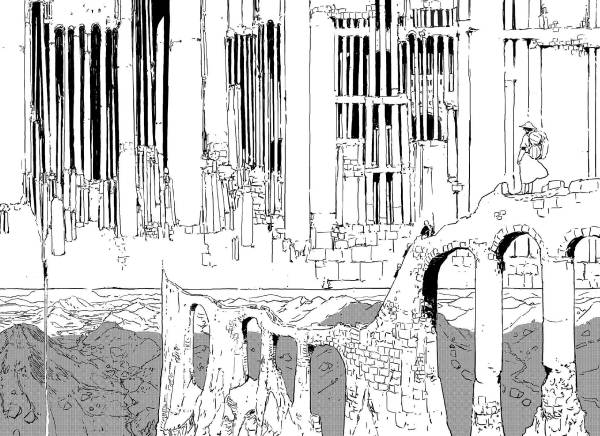
Tower Dungeon marks a surprising turn in Tsutomu Nihei’s career. Known for his silent science-fiction epics like Blame! and Biomega, Nihei trades his cybernetic labyrinths for a medieval world ruled by sorcery, monsters, and an impossibly vast tower.
The premise could not be more traditional. After an evil sorcerer slays the king, takes over his body, and kidnaps the princess, he carries her off to the legendary Dragon Tower. The royal knights attempt a rescue, only to be crushed, and in the aftermath a humble farmhand named Yuva is conscripted to help climb the tower. Carrying supplies and armed with little more than a pot lid for a shield, he joins the remnants of the expedition and begins an ascent through the horrors that await within.
Nihei fuses this classic setup with his trademark fascination for architecture. The Dragon Tower isn’t just a building but a character in its own right. Its scale is impossible, its geometry oppressive, and its constricted corridors are populated by grotesque monstrosities.
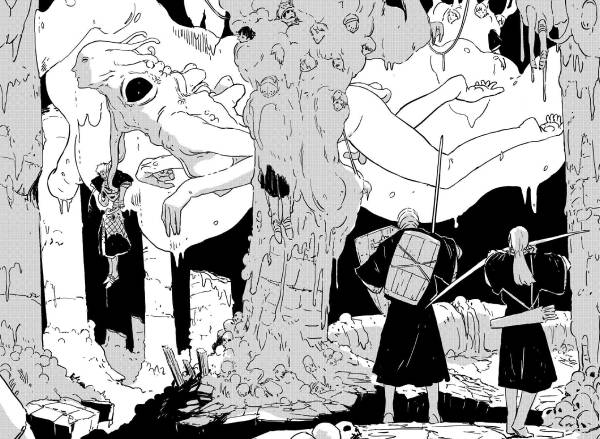
The art style is closer to Aposimz, featuring the same soft lines and lighter tone. The characters are simple and expressive, standing in sharp contrast to the dense, textured architecture surrounding them. At first glance, the linework can appear rough, but once Yuva and his companions enter the tower, the style begins to work. The looseness adds energy, giving the battles a chaotic intensity that suits the manga’s blend of fantasy and horror.
Where the art stands out is in the creature design. Nihei’s monsters aren’t your typical dragons or demons, but strange abominations, their forms as alien as those of the cybernetic monstrosities from Blame! We encounter shape-shifting dragonkin, giant basilisks, and zombies reminiscent of the rotten, biomechanical drones of Biomega.
One thing that separates Tower Dungeon from Nihei’s older works is accessibility. Where Blame! and Biomega often felt cold and cryptic, Tower Dungeon carries a strange warmth. Yuva and his companions are likeable and human in a way few of Nihei’s earlier characters were. Their camaraderie, small jokes, and banter add humanity to their ascent.

That said, Tower Dungeon remains a niche title for a reason. The pacing is slow due to the monthly release schedule, but also Nihei’s habit of favoring atmosphere over explanation. The world beyond the tower is only hinted at through fragments, but almost none of them are shown. For some readers this can be frustrating; for others, it’s a defining trait of Nihei’s work.
While it may not match the monumental scale of Blame!, Tower Dungeon stands as a fascinating experiment. It combines the visual enormity of Nihei’s cyberpunk imagination with the grounded appeal of a dark fantasy manga. It’s a hidden gem, where architecture takes center stage.
Genres: Dark Fantasy, Adventure, Action
Status: Ongoing (Shonen)
9. Demon Slayer
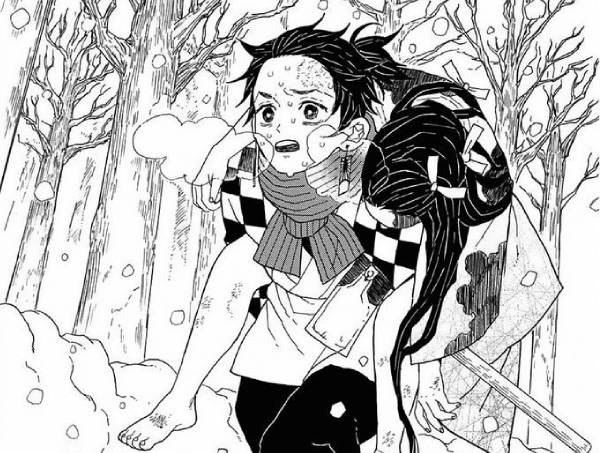
Few manga have ever ignited the industry like Demon Slayer: Kimetsu no Yaiba. Koyoharu Gotouge’s debut began as a modestly successful shonen series before exploding into a cultural phenomenon that even dethroned One Piece in sales. It’s a work that doesn’t attempt to refine the genre, but instead perfects it, channeling the emotional clarity and traditional structure of classic shonen through a distinctly darker, more tragic lens.
At its core, Demon Slayer is a revenge story. Tanjiro Kamado returns home to find his family slaughtered by demons, with only his sister Nezuko surviving, though transformed into one of them. He sets out bent not only on revenge but also on finding a cure for her. This duality becomes the manga’s central theme: a brother’s compassion in a world that defines monsters as irredeemable.
While Demon Slayer operates as an action-adventure, its tone often borders on gothic tragedy. Every demon once had a name, a life, and sorrow that turned into something monstrous. These personal histories unfold during battle, turning each fight into a moment in which hunter and hunted have to confront their humanity. The result is a series that often feels mournful rather than triumphant.
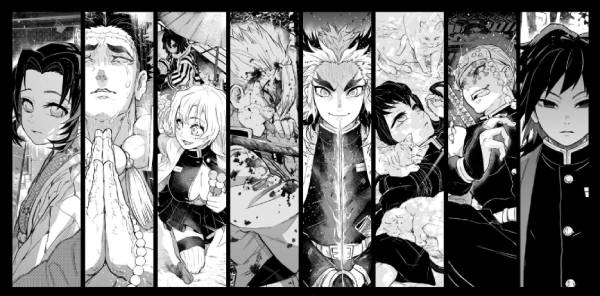
The battles themselves are the series’ visual heartbeat. Gotouge’s art may seem simple at first glance, but their use of motion, rhythm, and elemental imagery is breathtaking. Each Breathing Style feels alive, be it a swirl of water, a flare of flame, or a violent gush of wind. These flowing attacks give the combat an almost poetic rhythm.
One of the most remarkable things about Demon Slayer is how it turns predictability into strength. The structure is pure shonen: training arcs, ranked enemies, escalating powers, tragic flashbacks, and an inevitable final confrontation. Yet, instead of feeling tired, the formula feels revitalized by sincerity and pacing. There’s no bloat, no meandering subplots, and every chapter drives the story toward a decisive conclusion.
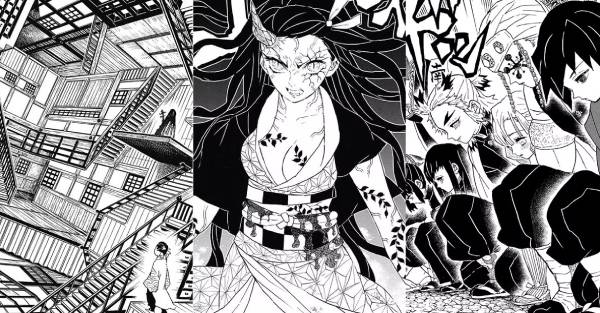
Critics often point to its familiarity, and it’s true that Demon Slayer doesn’t reinvent either dark fantasy or shonen storytelling. But what it offers is refinement, a clear emotional through line that never loses focus. Its world of demon-slaying swordsmen may echo countless predecessors, yet few portray that struggle with such earnest conviction.
By the end, Tanjiro’s journey closes as cleanly as it began, without dragging on past its emotional peak. It’s a rare manga that knows exactly when to end. Demon Slayer: Kimetsu no Yaiba might not be the most daring dark fantasy manga on this list, but it remains one of the most finely crafted.
Genres: Dark Fantasy, Action, Adventure, Tragedy
Status: Completed (Shonen)
8. Black Butler
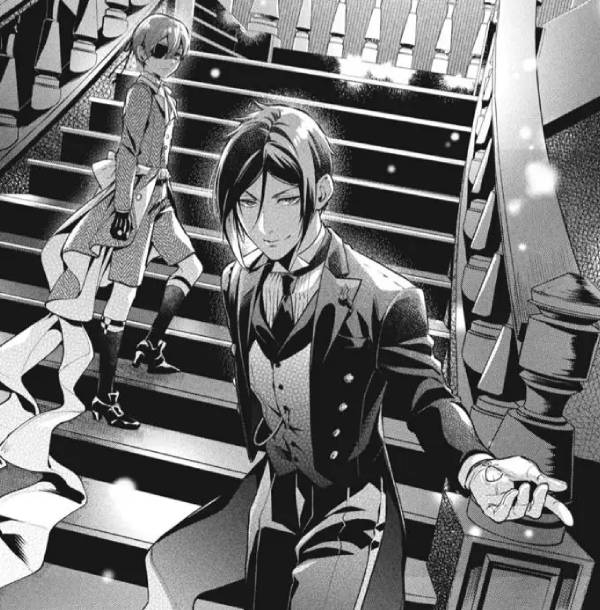
At first glance, Black Butler seems like a quirky, over-the-top shonen series about an impossibly perfect butler and his bratty master. The opening chapters do little to challenge that impression and lean closer to comedy than horror. But that lighthearted facade gradually fades, and what lies beneath is a twisted and atmospheric dark fantasy manga.
Set in Victorian England, Black Butler follows Ciel Phantomhive, a twelve-year-old earl who serves as the Queen’s Watchdog, an agent tasked with investigating crime in London’s underworld. At his side stands Sebastian Michaelis, his loyal butler. Together, they investigate murder mysteries, supernatural conspiracies, and the darkness below England’s polished high society.
The first few arcs can be daunting. The tone wavers between grim and goofy, mixing broad humor, the exaggerated Phantomhive servant antics, and even a curry-cooking competition that feels entirely out of place. Yet as Black Butler progresses, its true identity becomes increasingly clear. By the time the iconic Circus Arc begins, the series has fully transformed into a genuine gothic thriller exploring childhood trauma, the illusion of morality, and the thin line between civility and savagery.
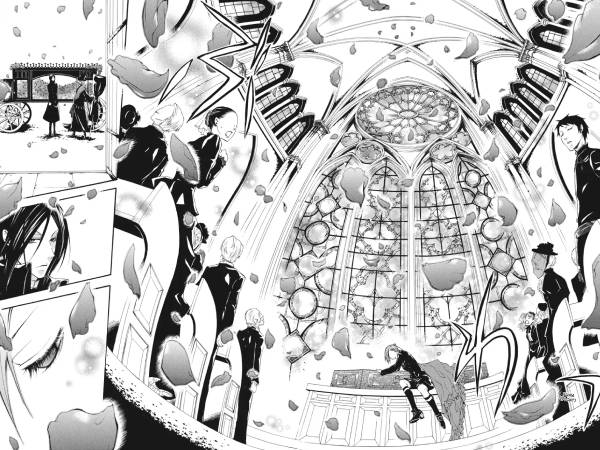
It’s this ability to evolve that makes Black Butler so fascinating. What starts out as a supernatural comedy slowly turns into a sinister, gothic tale whose best moments can rival masterpieces like Godchild.
Ciel himself is an unorthodox protagonist. Despite his youth, he carries the weight of unimaginable suffering: orphaned, branded, and forced into a Faustian pact to survive. His cold, calculating demeanor often borders on cruelty, and his partnership with Sebastian is built on necessity, not affection. Sebastian’s charm and humor seem to mask something inhuman, and it’s never quite clear whether his rare moments of care are genuine or merely indulgent play.
Visually, Black Butler can be uneven, especially in earlier chapters. Toboso has a talent for both the elegance and decay of Victorian London. The costumes are meticulously drawn, and the gothic architecture is full of mood and texture. The circus arc stands out in particular, full of theatrical details, expressive body language, and dramatic contrast. Yet when the setting is not drenched in his typical gothic aesthetic, it can feel rather uninspired and even bland.
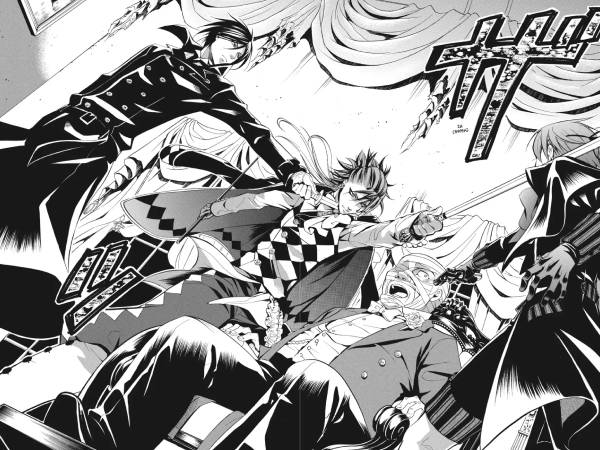
The manga’s structure also remains episodic throughout its entire run, alternating between standalone mysteries and longer, serialized arcs. Some arcs, particularly the earlier ones, suffer from uneven pacing or overly shonen flair. Another point of contention is the innuendos involving Ciel, which not only feel out of place, but are rather off-putting.
Black Butler is not a flawless manga, and getting through the earlier chapters can be a challenge, but those who persist will find a surprisingly rich and sinister dark fantasy experience.
Genres: Dark Fantasy, Mystery, Gothic, Supernatural
Status: Ongoing (Shonen)
7. Made in Abyss
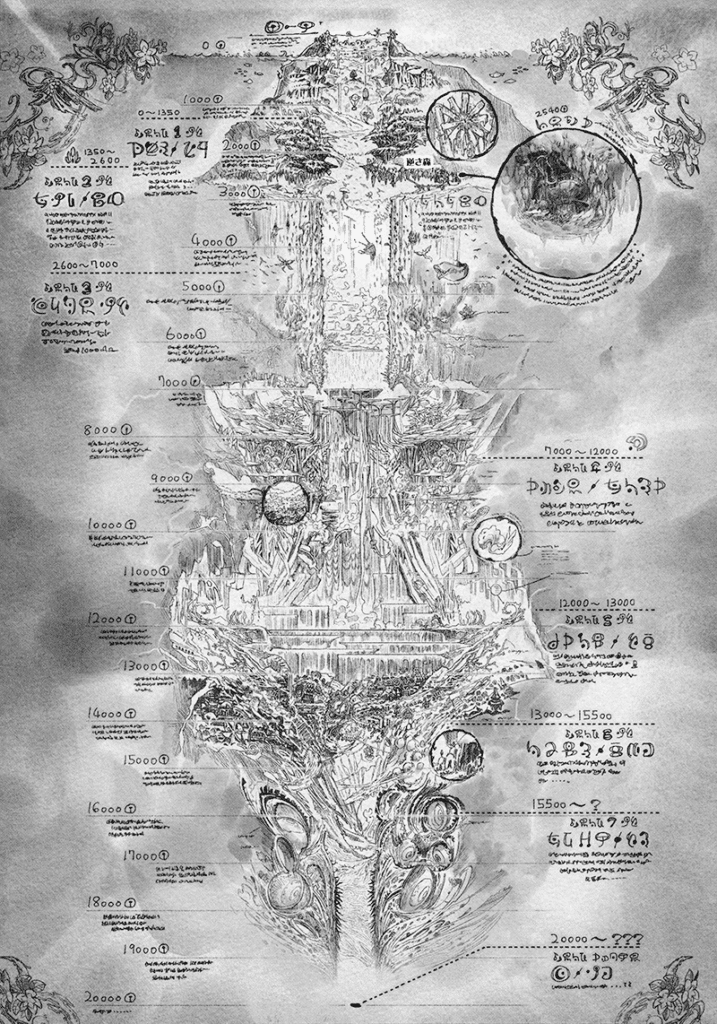
Few dark fantasy manga build a world as haunting and alluring as Made in Abyss. Written and illustrated by Akihito Tsukushi, this series is a masterclass in environmental storytelling that pulls readers into one of the most striking settings ever imagined.
At the heart of the story lies the Abyss: an immense vertical pit that plunges deep into the earth, layered with ancient ruins, alien ecosystems, and relics of lost civilizations. At its edge lies the city of Orth, home to adventurers known as Cave Raiders who risk their lives exploring its depths. Among them is Riko, a curious orphan whose mother vanished into the chasm years before. When Riko discovers a mysterious robot boy named Reg on one of her expeditions, she becomes convinced that his existence is tied to her mother’s fate. Together, they descend into the Abyss, chasing answers that lie far beyond the reach of sunlight.
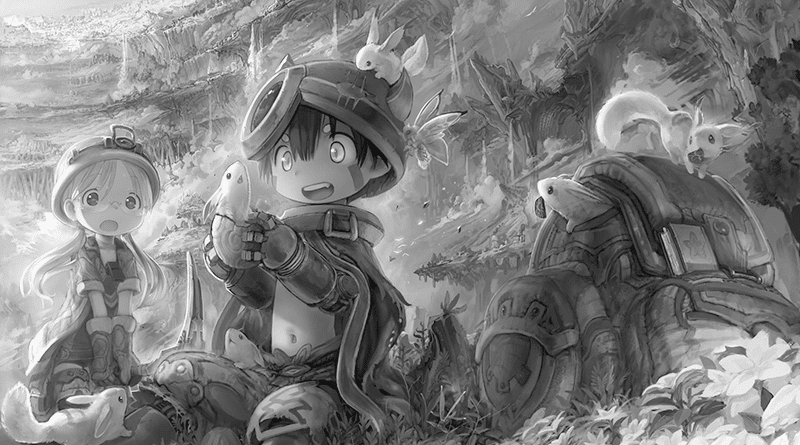
At first, Made in Abyss presents itself as a whimsical adventure. The childlike art style and playful tone create an illusion of safety with soft faces, rounded silhouettes, and backdrops of wonder. Yet as the descent continues, the manga’s true nature reveals itself. Each new layer of the Abyss brings breathtaking vistas alongside fresh horrors: mutated beasts, grotesque relics, and the infamous Curse of the Abyss, an otherworldly affliction that makes ascending excruciatingly painful, if not impossible.
Tsukushi’s art plays a crucial role in this transformation. Every page is meticulously drawn, filled with intricate textures and alien details that make the Abyss feel alive. The mix of innocence and monstrosity is where Made in Abyss earns its place among the best dark fantasy manga. The visual contrast between fragile children and surreal, hostile environments creates a stark dissonance.
What begins as exploration soon becomes a struggle for survival. The manga’s gradual descent mirrors a moral and emotional one as curiosity gives way to obsession, and innocence dissolves under the weight of what Riko and Reg encounter. Tsukushi’s world is merciless yet hypnotic, rewarding the brave while punishing the naïve. The deeper they go, the more the story exposes the cost of knowledge and the cruelty of discovery.
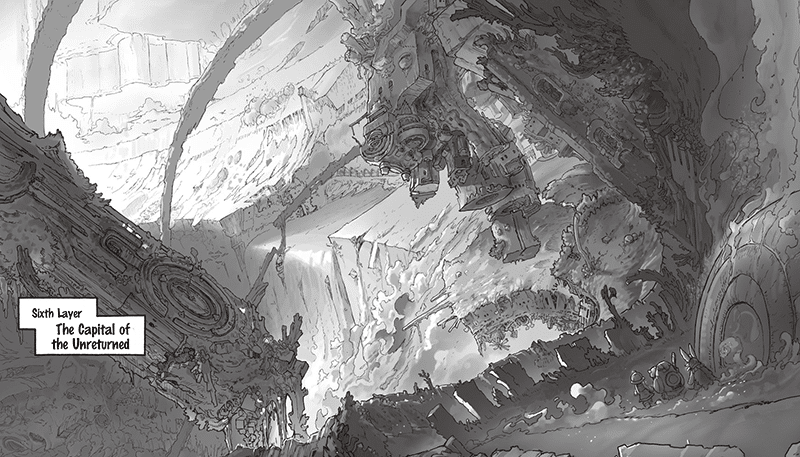
It’s impossible to discuss Made in Abyss without acknowledging its disturbing edge. Despite its child protagonists, the series contains moments of shocking brutality: graphic injuries, psychological trauma, and acts of survival that feel almost unbearable to witness. Whether this mix of innocence and horror is meant to deepen tragedy or simply provoke discomfort remains debated, but the effect is undeniable.
For readers drawn to intricate worlds, emotional storytelling, and the unsettling beauty of the unknown, Made in Abyss is a must-read. It’s a dark fantasy manga as gorgeous as it is grotesque.
Genres: Dark Fantasy, Adventure, Sci-Fi
Status: Ongoing (Seinen)
6. Shin Angyo Onshi
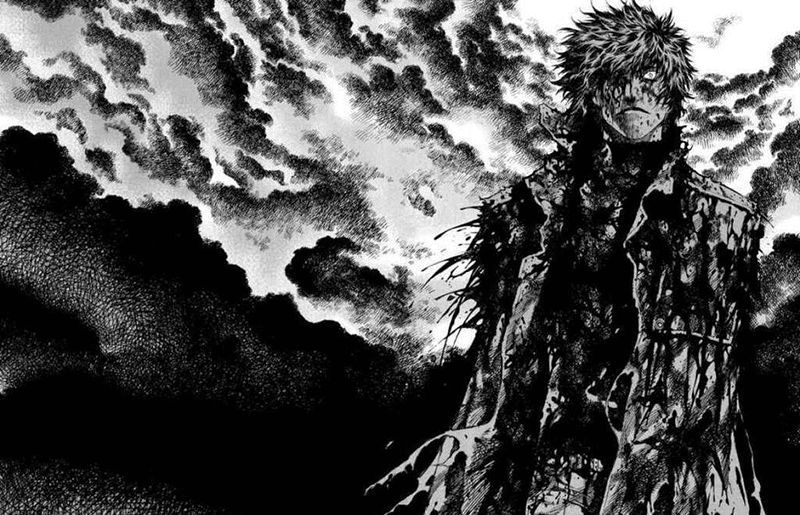
Few series blend Korean myth, samurai-style vengeance, and political tragedy as powerfully as Shin Angyo Onshi. Created by In-Wan Yoon and Kyung-il Yang, this Korean-made dark fantasy was serialized in Japan, giving it the structure of a manga, but the moral gravity of a Korean epic. Its blend of sharp artwork, moral ambiguity, and tragic storytelling makes it one of the most underappreciated dark fantasy manga of its era.
The story takes place in the fallen kingdom of Jushin, once protected by secret government agents known as the Angyo Onshi, wandering enforcers who punish corruption and defend the innocent. Among the few who survived Jushin’s collapse is Munsu, a cynical, battle-hardened agent who continues to deliver justice long after the kingdom’s destruction. He now roams the ruined land, chasing redemption and revenge.
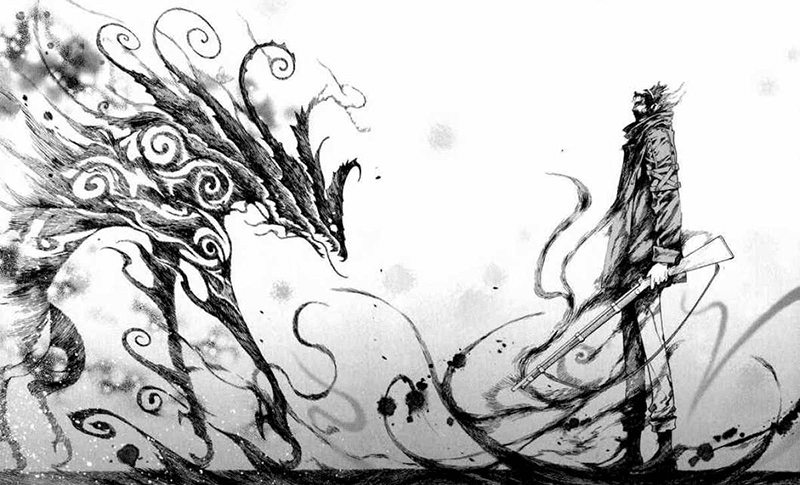
Early on, the series follows a mostly episodic structure. Munsu travels from town to town, exposing greed, cruelty, and human weakness wherever he finds it. These chapters work almost like twisted fables, each revealing another fragment of the manga’s broken world. But as the story progresses, a much larger narrative emerges, one that reveals the cause of Jushin’s fall, the truth behind Munsu’s past, and the shadow of a former friend turned nemesis.
It’s around this midpoint that Shin Angyo Onshi truly comes into its own. What begins as a wandering samurai tale grows into a sweeping revenge epic of tragedy, war, and supernatural forces. Munsu’s journey becomes as much about vengeance as it is about facing guilt and loss. His methods are ruthless; his morality is fractured.
Kyung-il Yang’s artwork deserves particular praise. The linework is cinematic, filled with dramatic compositions and painterly backgrounds that rival the best seinen manga. Every battlefield and ruin feels alive, and the combat sequences have a brutal elegance. The character design, especially for Munsu and his enemies, radiates charisma and menace in equal measure.
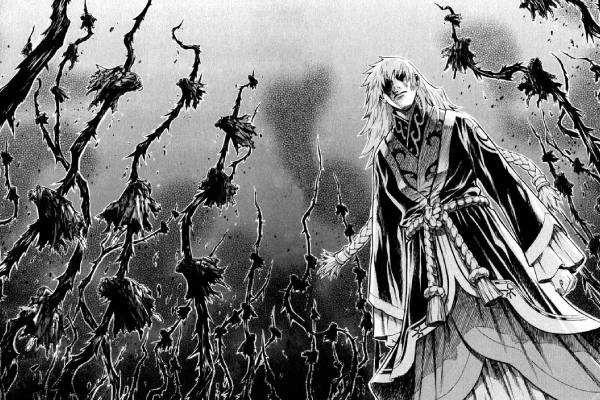
Like many great dark fantasy manga, the series has its uneven moments. The opening volumes are slower and more episodic, occasionally weakened by tonal shifts or misplaced humor. Supporting characters, like the scantily clad Sando, sometimes feel at odds with the story’s grim tone. Once the main narrative takes shape, however, the manga transforms into something exceptional. As the emotional stakes deepen, the violence carries moral consequences, and the world’s tragic history comes into focus.
Shin Angyo Onshi may take time to find its footing, but by its conclusion, it delivers one of the most satisfying and thematically rich endings in all of dark fantasy manga. For those who enjoy the bleak heroism of Berserk or the moral weight of Claymore, Shin Angyo Onshi is a must-read.
Genres: Dark Fantasy, Action, Supernatural, Drama
Status: Completed (Seinen)
5. Attack on Titan
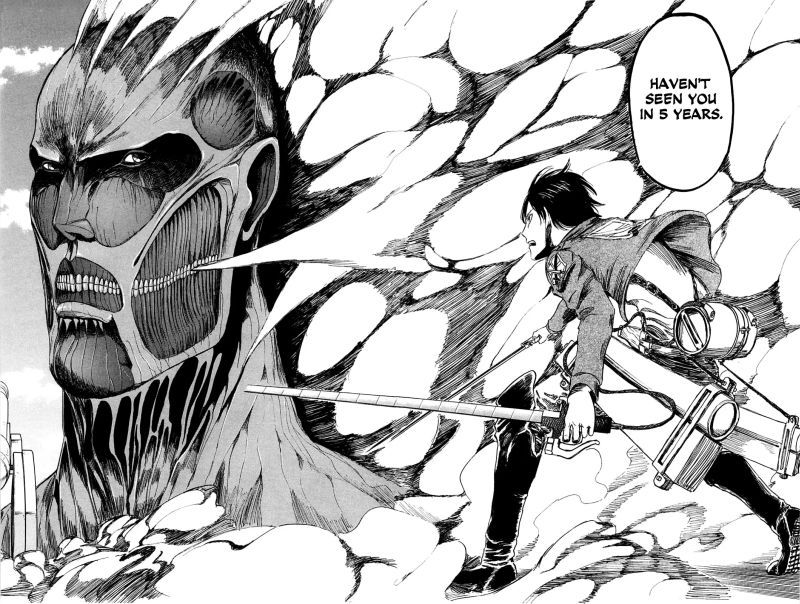
Few manga have shaken the industry like Attack on Titan. When Hajime Isayama first introduced his grim, claustrophobic world, it began as a niche dark fantasy about survival and fear but soon grew into one of the most influential and debated manga of the modern era. Combining elements of apocalyptic horror, military drama, and political mystery, Attack on Titan redefined what dark fantasy could look like within the shonen genre.
The story opens within a massive walled city. This is humanity’s last refuge against the Titans, towering humanoid creatures that devour humans. For generations, the walls provided a fragile illusion of safety, until one day a colossal Titan breached the outer barrier, unleashing chaos and death. Among the survivors is Eren Yeager, a boy whose mother was killed in the attack. Driven by grief and rage, he joins the military alongside his friends Mikasa and Armin, vowing to exterminate every Titan in existence. But soon, Eren discovers a horrifying secret: he possesses the power to transform into a Titan himself.
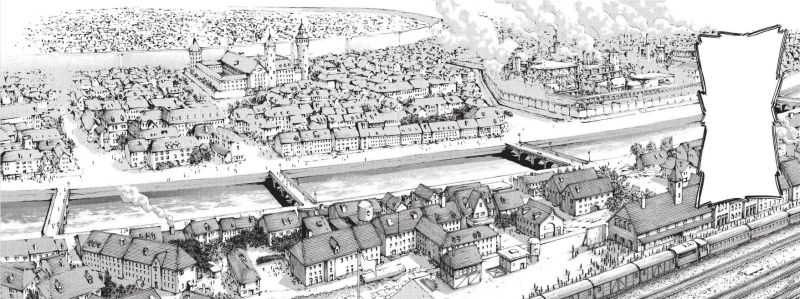
That single twist launches Attack on Titan from a tale of vengeance into an ever-expanding mystery. The early arcs thrive on tension and claustrophobia. Humanity huddles behind walls, soldiers die on expeditions, and the Titans are an ever-looming, horrible presence. As the manga progresses, new revelations about the Titans peel back the world’s layers, forcing both characters and readers to question everything they thought they understood.
Artistically, the series has always divided readers. The early chapters are undeniably rough, with crude anatomy and rigid panels, but Isayama’s growth over time is extraordinary. By the series’ midpoint, his style sharpens into something dynamic and cinematic. The vertical maneuvering gear sequences stand among the most exhilarating action scenes in manga, fast, kinetic, and drenched in a strange sense of realism. The Titans themselves, drawn as naked, grinning parodies of humanity, are among the most disturbing monster designs ever put to page.

As the story continues, it shifts from this visceral horror toward complex moral conflict. The later volumes trade immediate dread for political intrigue and global warfare, exploring themes of nationalism, rebellion, and the futility of hatred. Not all fans, myself included, appreciated this tonal evolution, and many missed the pure survival horror of the earlier arcs.
And then there’s the ending. Even years after its conclusion, few endings in manga have provoked such heated debate. Some readers admire its tragic scope and bold choices, while others see it as a betrayal of the characters and themes that came before.
Despite its flaws, Attack on Titan stands as one of the defining dark fantasy manga of its generation. Brutal, emotional, and unflinchingly ambitious, it uses shonen action to tell a story about fear, power, and the price of freedom.
Genres: Dark Fantasy, Action, Mystery, Post-Apocalyptic
Status: Completed (Shonen)
4. The Witch and the Beast

Among modern dark fantasy manga, few works have impressed me as much as The Witch and the Beast by Kousuke Satake. It’s stylish, intricate, and visually mesmerizing, a rare series that fuses gothic aesthetics, mythic storytelling, and cinematic paneling into something uniquely its own. While it’s not as widely discussed as it deserves to be, I genuinely think this is one of the best dark fantasy manga of the last decade.
Set in a world haunted by witches and magic, the story follows an unlikely pair: Guideau, a brash, impulsive young woman, and Ashaf, a calm, enigmatic man who travels with a coffin strapped to his back. Together, they serve the Order of Magical Resonance, an organization tasked with investigating supernatural crime. Guideau’s personal goal, however, is far more vengeful: she’s searching for the witch who cursed her, hoping for either a cure or a chance at revenge.

The manga is rather episodic, with Guideau and Ashaf arriving in cities afflicted by strange curses or magical outbreaks. Each case introduces not only new forms of magic but also new characters. The standout is Phanora Kristoffel, a necromancer whose side story functions as a perfectly self-contained tale in a larger universe.
The Witch and the Beast’s world thrives on atmosphere, full of vast cityscapes, rain-soaked cobblestones, and gothic architecture. Satake’s art is exquisite, some of the best in modern manga, defined by jagged, sketch-like linework that gives everything a sense of movement. The action sequences are chaotic but alive, filled with fluid motion and otherworldly details. The creature design ranks among the best in years, with Phanora’s death knights as clear highlights. It’s the kind of art you can get lost in, just admiring how gorgeous certain pages look.
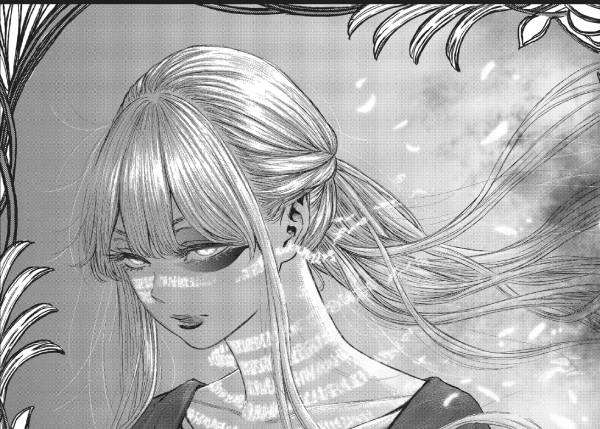
Narratively, the manga is more opaque. Satake rarely tells; instead, he reveals his world through dialogue, behavior, and subtle events. While it can be grating to some readers, it perfectly fits the manga’s tone.
Still, The Witch and the Beast isn’t without flaws. The vampire arc, while ambitious, introduces a sudden tonal shift and a flurry of lore that can feel disorienting. The pacing can drag, particularly in later arcs, and some of the battle scenes are so visually dense that they become hard to follow. Character-wise, Guideau can be grating, her constant rage occasionally undercutting the story’s tone. Ashaf, by contrast, is fantastic: reserved, composed, and full of quiet mystery.
Unfortunately, the series went on an indefinite hiatus in 2023 due to the author’s poor health. It’s an enormous shame, because the manga was still expanding, weaving past arcs together and reintroducing earlier characters, hinting at a larger interconnected story. Few ongoing dark fantasy manga had this much promise.
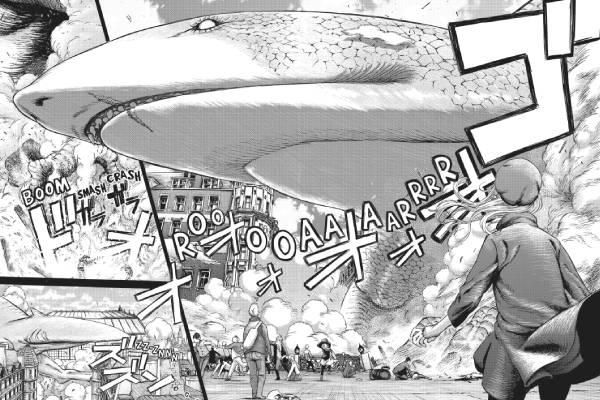
In the end, The Witch and the Beast feels like a forgotten gem, a gothic, melancholic epic that blends supernatural investigation with visual decadence. Its world of witches, necromancers, undead, and cursed souls is both haunting and seductive, brought to life with some of the most beautiful art in manga. An ornate masterpiece, The Witch and the Beast is one of my absolute favorite modern dark fantasy manga.
Genres: Dark Fantasy, Action, Supernatural
Status: On Hiatus (Seinen)
3. Claymore
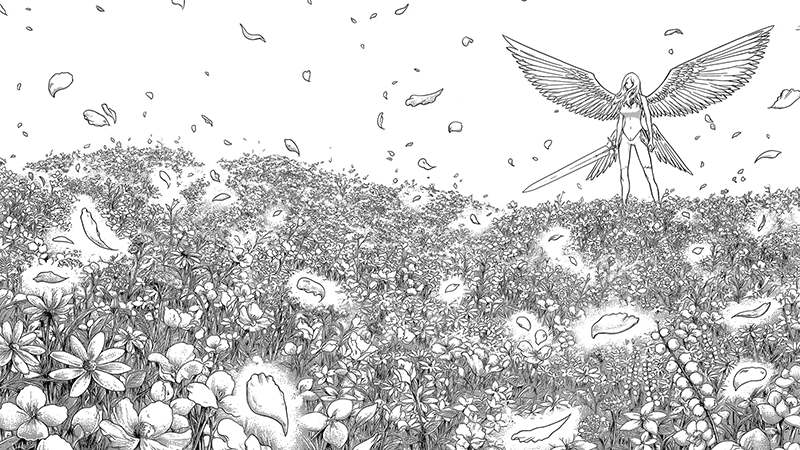
Norihiro Yagi’s Claymore remains a cornerstone of 2000s dark fantasy manga, a cold, brutal world of monsters, vengeance, and doomed heroines that stands apart from the flashier battle manga of its time. It’s grim, haunting, and filled with gothic energy.
The story unfolds in a bleak medieval setting overrun by Yoma, shape-shifting demons that feed on human flesh. To protect what’s left of civilization, a secretive organization engineers half-human, half-Yoma hybrids known as Claymores. They are silver-eyed warrior women capable of matching these monsters in battle, but always at risk of losing control and becoming one themselves. Among them is Clare, a stoic fighter whose calm demeanor hides a deep and painful past. Her quest for revenge against the monstrous Priscilla, who slaughtered her mentor Teresa, becomes the emotional and thematic core of the series.

At first, Claymore follows a familiar structure: short arcs of monster hunts that gradually reveal the world’s rules. As the chapters progress, the tone deepens, and the scale widens. What begins as isolated battles changes into a sprawling tale of self-determination and rebellion, not only against the Yoma but the very organization that created the Claymores.
Yagi’s artwork is outstanding, and balances horror and elegance. Long flowing lines define both the Claymores’ angelic beauty and the grotesque transformation of their enemies. The monster design deserves particular praise. Few artists have created monsters that look so otherworldly, yet so disturbingly organic and beautiful. Every fight feels like Clare and her allies are facing off against some sort of eldritch abomination.
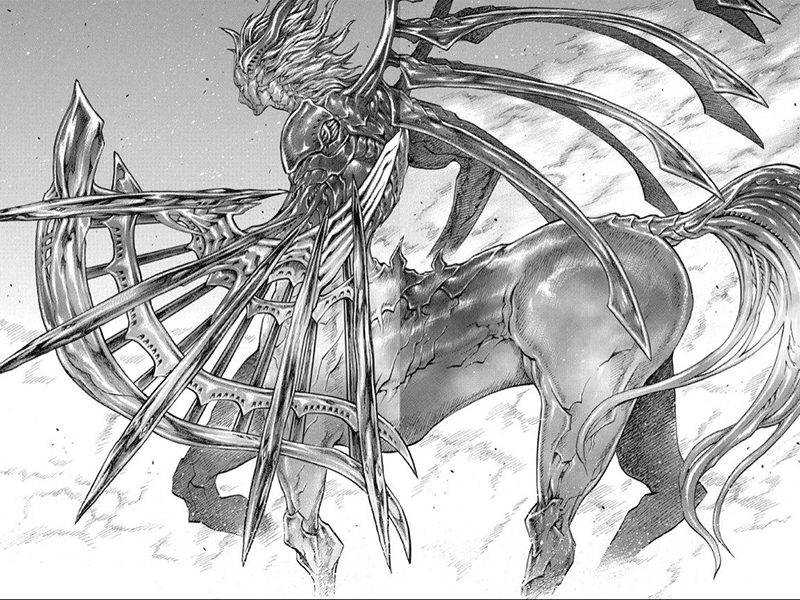
Still, Claymore isn’t flawless. The battle choreography, while intense, sometimes becomes chaotic, with angles and perspectives that obscure rather than enhance action. The settings, though gorgeously rendered, are often underused, with battles taking place in empty spaces rather than making use of the intricate environments. The villain Priscilla, built up early as the ultimate threat, disappears for most of the story, and her late reappearance dulls some of the tension. And while the final arc offers long-awaited answers about the Yoma and the organization’s origins, its exposition-heavy reveal feels abrupt and verges on deus ex machina.
Even so, Claymore’s strength far outweighs its stumbles. It’s a rare series where tone, art, and theme align perfectly to create a story about identity, humanity, and revenge. For readers who love the medieval despair of Berserk but prefer a more structured, mission-driven narrative, Claymore is a must-read. It combines the grit of seinen storytelling with the pacing of shonen adventure to create something beautifully hybrid and unforgettable.
Genres: Dark Fantasy, Action, Supernatural
Status: Completed (Shonen)
2. Dorohedoro
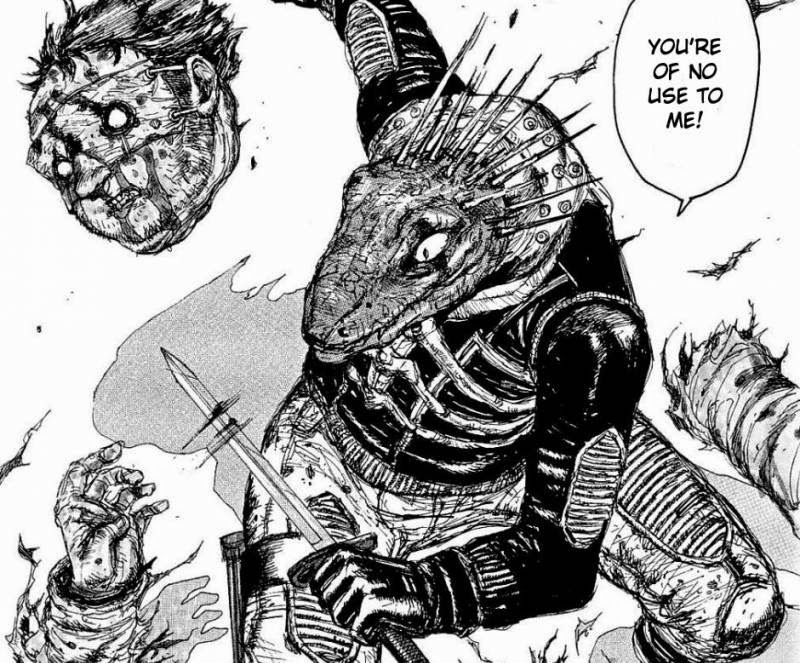
There are dark fantasy manga, and then there’s Dorohedoro, Q Hayashida’s filthy, funny, and utterly unhinged masterpiece. It’s not your typical dark fantasy by any measure. Instead of knights and castles, it offers gangsters, mutants, and sorcerers rampaging through a postindustrial hellscape. Equal parts horror, absurdist comedy, and surreal urban fantasy, Dorohedoro is as grotesque as it is heartfelt, a work that defies all conventions.
The story takes place in Hole, a decrepit city suffocating under smoke, grime, and decay. This urban wasteland is used as a testing ground by magic users from a different dimension, the Sorcerer’s World. Here, they experiment on the powerless residents, transforming them into monsters, corpses, or worse. The result is a society where death, mutation, and violence are part of daily life.
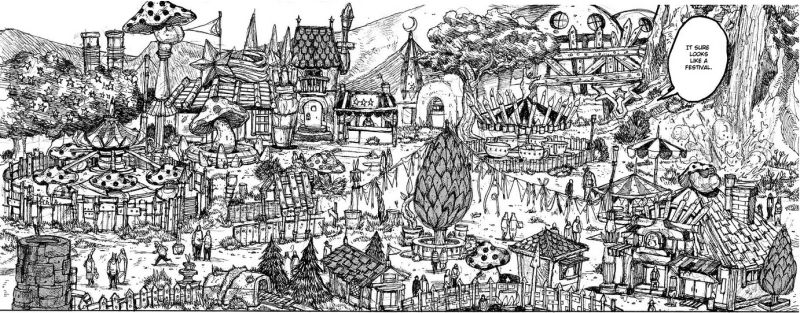
Amid this chaos, we meet Kaiman, a man with a reptilian head and no memory of who he used to be. Immune to magic and obsessed with uncovering the truth behind his transformation, he hunts down sorcerers alongside his partner Nikaido, a cheerful yet mysterious woman who runs a restaurant and harbors secrets of her own. Their escapades form the backbone of the story, but what begins as a simple revenge plot quickly spirals into something much larger, a tangled web of secret histories, parallel worlds, and shifting loyalties that bind Hole and the Sorcerer’s World together.
What makes Dorohedoro such a brilliant dark fantasy manga is its duality. For every scene of horrifying violence, there’s a moment of absurd comedy. One chapter might make you laugh at a giant talking cockroach named Johnson; the next will confront you with some of the most disturbing gore in mainstream manga. It’s an impossible balance that somehow works, giving the series an unpredictable rhythm few creators could ever achieve.
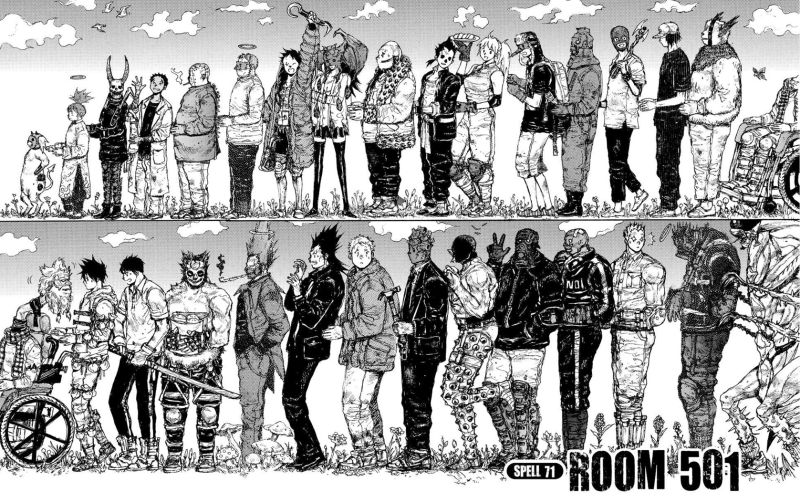
Hayashida’s art is equally striking. Her world is dense and chaotic, drawn with gritty, hand-textured detail that feels tangible and alive. Hole is a festering industrial labyrinth, while the Sorcerer’s World feels like a surreal gothic fever dream. The character and creature designs are unforgettable. We see patchwork sorcerers in plague masks, stitched-together demons, and monstrous hybrid forms that look straight from a nightmare. Despite all the filth and gore, every page feels deliberate, beautifully constructed, and bursting with imagination.
One of Dorohedoro’s most fascinating traits is its moral ambiguity. There are no heroes, only killers, freaks, and survivors. Yet everyone, even the most grotesque villain, is oddly likeable. Hayashida turns her world of blood and ruin into something weirdly warm and human.
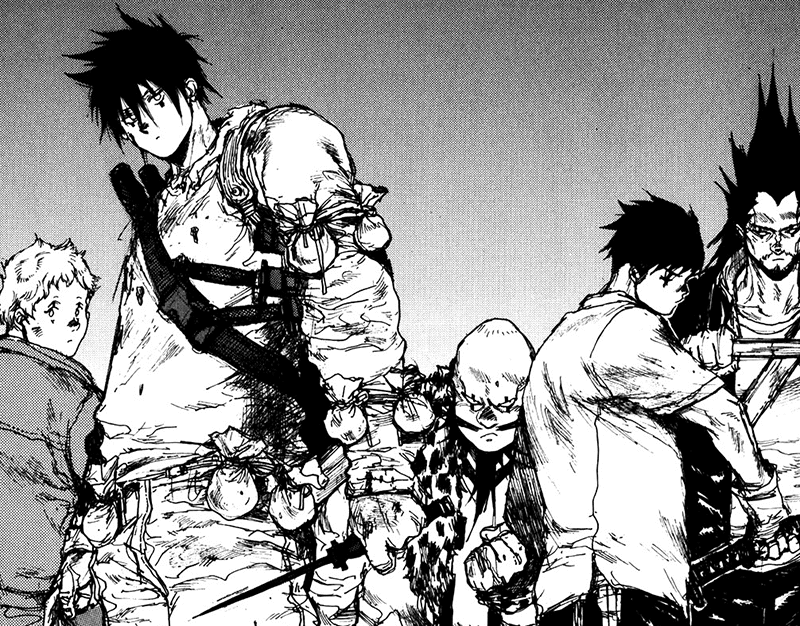
Still, Dorohedoro is not for the faint of heart. The violence is relentless, and the later arcs dive headfirst into pure nightmare fuel. For some, the dense lore and surreal structure may feel overwhelming. For others, that’s exactly what makes this manga so intoxicating, a dive into chaos that never feels random, only purposeful in its madness.
Grotesque, hilarious, and deeply imaginative, Dorohedoro is one-of-a-kind dark fantasy. Beneath the blood and absurdity lies a strangely touching story about friendship, identity, and survival in a dark, twisted world. It’s violent, bizarre, and often disgusting, yet it remains one of the best dark fantasy manga ever made, and easily the most unique.
Genres: Dark Fantasy, Horror, Supernatural, Mystery, Slice of Life
Status: Completed (Seinen)
1. Berserk
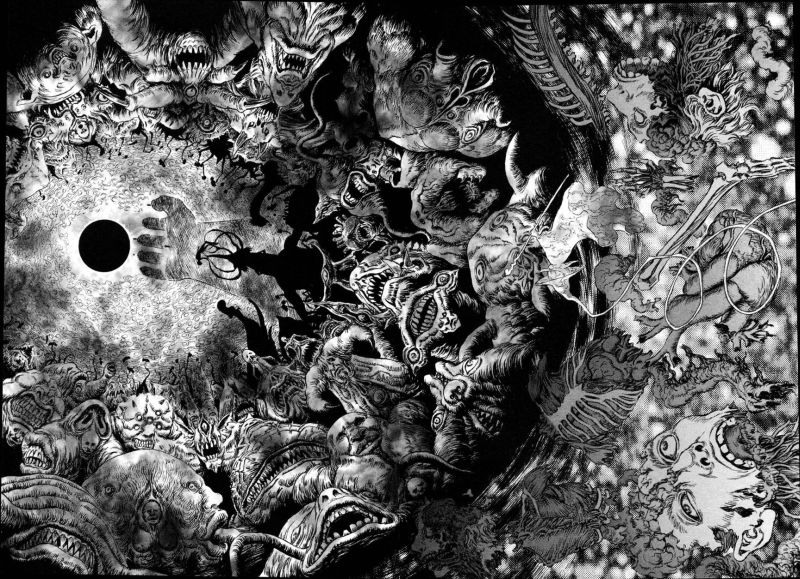
If there’s one manga that defines dark fantasy, it’s Berserk. Kentaro Miura’s magnum opus isn’t merely a great manga; it’s a cultural landmark, a brutal meditation on fate, suffering, and the will to survive. Every page radiates intensity, from the raw savagery of its action to the staggering intricacy of its artwork. Few series in any medium have achieved this level of depth, influence, or visual perfection.
The story follows Guts, the infamous Black Swordsman, a lone mercenary who cuts through both man and monster with a sword as large as himself. His journey begins with vengeance, driven by a desire to kill Griffith, the charismatic leader of the Band of the Hawk who betrayed him. What starts as a tale of blood and revenge grows into something far greater: an epic about destiny, ambition, and those who struggle against fate.
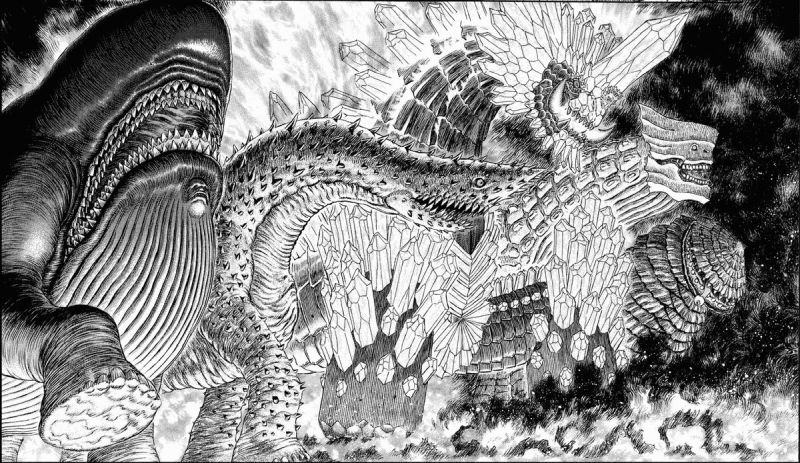
Berserk opens with the Black Swordsman Arc, a descent into a medieval nightmare, full of demonic horrors called apostles, and a Guts so violent and detached he appears more villain than hero. But then comes the Golden Age Arc, the series’ emotional core. Here, Miura slows the pace, turning what began as a revenge fantasy into a sweeping tragedy of friendship and betrayal. Guts is turned from a hollow killer into a fully realized human being, while Griffith evolves into one of the most fascinating and terrifying antagonists in manga. Their intertwined destinies, one black and of rage, the other white and of ambition, form the duality of Berserk.
That duality runs through the entire series. For every moment of beauty, there’s horror; for every spark of hope, a plunge into despair. The Lost Children and Conviction arcs in particular push the boundaries of darkness in fiction. They aren’t just violent, but existentially bleak, filled with some of the most grotesque imagery in manga. And yet, Miura never loses sight of the story’s human heart. Gut’s feelings for Casca, his gradual rediscovery of compassion, and the fragile friendships he forges along the way remind us that even in a world such as this, humanity endures.
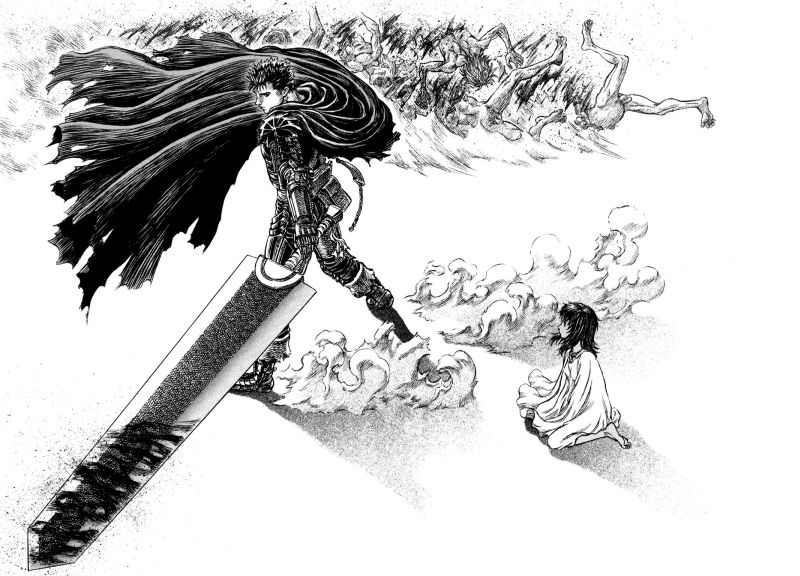
Miura’s art is the stuff of legend. His landscapes are stunning, his medieval castles meticulously detailed, and his battlefields are among the greatest in manga history. The apostles are among the most inventive and disturbing creature designs ever drawn, equal parts grotesque and mesmerizing. It’s no exaggeration to say that Berserk features some of the most beautiful and horrifying artwork in manga history.
Still, Miura’s vision isn’t without excess. Some scenes, especially those featuring the infamous Wyald, cross the line into indulgence, their brutality so extreme and erratic that it feels gratuitous. The series’ pacing fluctuates, alternating between epic battles and drawn-out contemplative stretches. Yet these imperfections only highlight how ambitious a work it truly is.
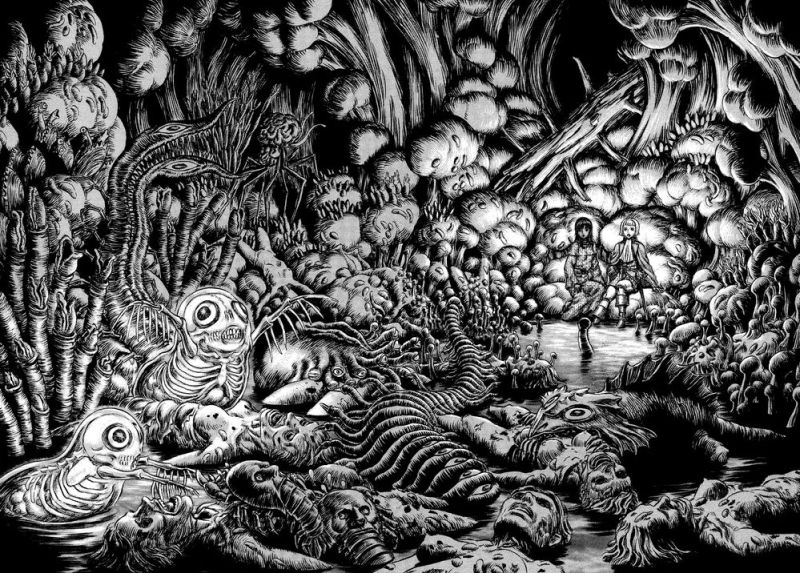
Berserk’s influence on dark fantasy is immeasurable. Video games like Dark Souls, Elden Ring, and countless other manga owe their grim tone and monstrous aesthetics to Miura’s vision. The series reshaped how fantasy itself could be portrayed, not as a heroic adventure, but as a tale of cosmic despair. It’s not just dark fantasy; it’s bleak fantasy.
Tragically, Kentaro Miura passed away in 2021 before completing his life’s work. His close friend Kouji Mori, entrusted with Mirua’s outlines and story plans, continues the manga alongside Miura’s longtime assistants. Whether the full scope of Berserk will ever be realized, however, remains unknown.
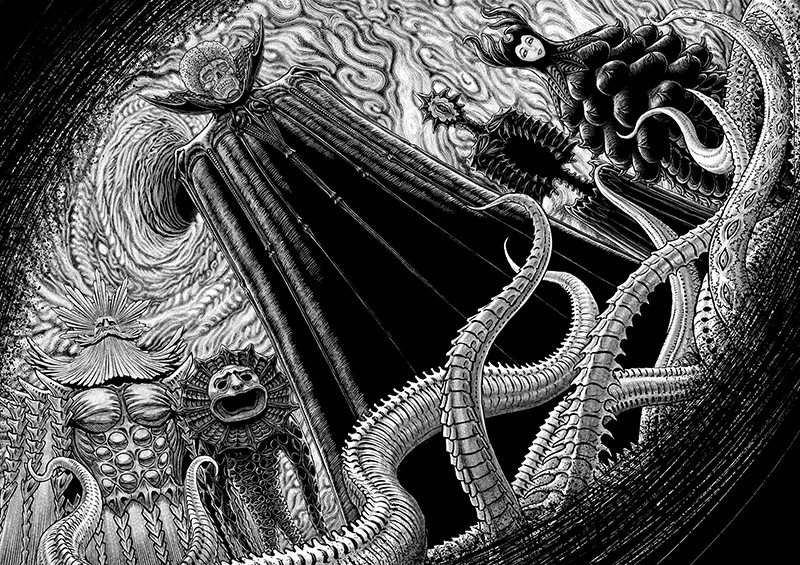
At its heart, Berserk is about the will to keep moving forward, even when fate itself seems set against you. It’s brutal, profound, and endlessly human. For readers seeking the pinnacle of dark fantasy manga, there’s no contest: Berserk stands at the top, unmatched in ambition, artistry, and sheer emotional power.
Genres: Dark Fantasy, Action, Horror, Tragedy, Psychological
Status: Ongoing (continued by Kouji Mori after Kentaro Miura’s death)
